Physical Address
304 North Cardinal St.
Dorchester Center, MA 02124
The Normal Thyroid Gland, 1244
Thyroid Tumors: An Overview, 1244
Diagnosis of Thyroid Tumors, 1247
Tumors of Follicular or Metaplastic Epithelium, 1249
Tumors Showing C-Cell Differentiation, 1292
Tumors Showing Both Follicular and C-Cell Differentiation, 1300
Thymic and Related Branchial Pouch Tumors of the Thyroid, 1301
Tumors of Hematolymphoid Cells, 1304
Mesenchymal Tumors and Other Tumors, 1307
Unusual and Uncommon Tumors and Tumorlike Lesions of the Thyroid, 1310
Metastatic Malignant Neoplasm in Thyroid, 1310
Practical Issues in Diagnosis of Thyroid Tumors, 1311
Fine-Needle Aspiration Cytology of Thyroid Lesions, 1317
Intraoperative Frozen-Section Diagnosis of Thyroid Tumors, 1318
The thyroid gland is a bilobed organ situated in the anterior neck, in front of the upper trachea. It is derived embryologically from the floor of the primitive pharynx, as a downgrowth in the region of the developing tongue.
The normal thyroid weighs 15 to 40 g in the adult. Histologically it is composed of colloid-containing follicles lined by cuboidal cells with uniform round nuclei and dense chromatin. The follicular epithelium synthesizes thyroid hormones (thyroxine, triiodothyronine), which play an important role in the regulation of body metabolism.
Parafollicular C cells, believed to be derived from the ultimobranchial body, comprise a minor component of the thyroid gland. They are polygonal or spindled, with clear to pale cytoplasm, and occur singly or in small groups within the follicular basal lamina or in the interfollicular interstitium. They are difficult to identify on routine microscopy and are best visualized by immunostaining for calcitonin, which is the main hormonal product of these cells. They are not evenly distributed throughout the thyroid gland but are restricted to a zone in the middle to upper thirds of the lateral lobes, deep within the parenchyma along a hypothetic central axis.
Thyroid cancer is fairly common. According to GLOBOCAN 2018, the world age-standardized rate is 3.1 cases per 100,000 men (6.9 in most developed regions; 0.5 in least developed regions), and 10.2 cases per 100,000 women (23.1 in most developed regions; 1.5 in least developed regions). The incidence of thyroid cancer has steadily increased in most countries over the past two decades, predominantly attributable to an increase in papillary carcinomas. The increase is at least partly due to the trend to use liberal criteria in diagnosing papillary carcinoma (follicular variant) and the increased detection of small tumors by imaging techniques. However, since the incidence rates have increased for all sizes of tumors, other factors, such as environmental influences, might play a part. With the recent reclassification of noninvasive, encapsulated follicular variant of papillary carcinoma (which has accounted for about 20% of all thyroid cancers) as a nonmalignant tumor (noninvasive follicular thyroid neoplasm with papillary-like nuclear features [NIFTP]), the incidence of thyroid cancer is expected to decline in coming years.
The most common tumors and their frequencies are listed in Table 18A.1 . The classification of thyroid tumors, modified from the 2017 World Health Organization (WHO) classification, is listed in Box 18A.1 . According to the Surveillance, Epidemiology, and End Results (SEER) study, the 10-year relative survival rates of the major thyroid carcinomas are as follow: papillary carcinoma, 98%; follicular carcinoma, 92%; medullary carcinoma, 80%; anaplastic carcinoma, 13%. Surgery is the mainstay of treatment for thyroid carcinomas. For tumors showing follicular cell differentiation (follicular carcinoma, papillary carcinoma, poorly differentiated thyroid carcinoma), radioactive iodine and suppressive thyroid hormone therapies are often effective. Targeted therapies are also being used for resistant or advanced tumors, such as inhibitors of oncogenic kinases or vascular endothelial growth factor receptors.
| Tumor Type | Frequency |
|---|---|
| Papillary carcinoma | 80%–85% |
| Follicular carcinoma | 5%–10% |
| Medullary carcinoma | 2%–4% |
| Anaplastic carcinoma | 0.5%–5% |
| Poorly differentiated carcinoma | 2%–7% |
| Malignant lymphoma | 4%–5% |
Follicular adenoma (including hyalinizing trabecular tumor)
Follicular carcinoma
Minimally invasive
Encapsulated angioinvasive
Widely invasive
Other encapsualted follicular-patterned thyroid tumors
Noninvasive follicular thyroid neoplasm with papillary-like nuclear features (NIFTP)
Follicular tumor of uncertain malignant potential
Well-differentiated tumor of uncertain malignant potential
Well-differentiated thyroid carcinoma, NOS
Hurthle cell neoplasm (adenoma and carcinoma)
Papillary carcinoma
Mucoepidermoid carcinoma
Sclerosing mucoepidermoid carcinoma with eosinophilia
Mucinous carcinoma
Poorly differentiated thyroid carcinoma
Anaplastic (undifferentiated) carcinoma, including squamous cell carcinoma
Secretory carcinoma
Medullary carcinoma
Collision tumor: follicular/papillary and medullary carcinomas
Mixed medullary and follicular thyroid carcinoma
Ectopic thymoma
Spindle epithelial tumor with thymus-like differentiation (SETTLE)
Intrathyroid thymic carcinoma (carcinoma showing thymus-like element [CASTLE])
Malignant lymphoma
Langerhans cell histiocytosis
Follicular dendritic cell sarcoma
Parathyroid adenoma
Parathyroid carcinoma
Benign and malignant mesenchymal tumors, such as solitary fibrous tumor, smooth muscle tumor, peripheral nerve sheath tumor, angiosarcoma
Paraganglioma
Teratoma
Papillary carcinoma is the most common histologic type.
With the exception of angiosarcoma, thyroid cancers are two to four times as frequent in women as in men. The female gender is generally associated with a slightly better prognosis.
The differentiated tumors generally occur in younger patients, while the less differentiated tumors occur in older patients.
For the same tumor type, young patients below the age of 40 years generally fare considerably better than older patients.
Besides age, the size of the primary tumor and tumor stage are usually the most significant prognostic factors. The TNM staging for thyroid tumors (AJCC/UICC eighth edition) is listed in Box 18A.2 , and there are significant changes compared with the seventh edition.
a (m) refers to multifocal tumor, and the largest tumor determines the T category; minor extrathyroidal extension does not affect T category or overall stage.
TX Primary tumor cannot be assessed
T0 No evidence of primary tumor
T1 Tumor ≤2 cm, limited to the thyroid
T1a: Tumor ≤1 cm
T1b: Tumor >1 cm but ≤2 cm
T2 Tumor >2 cm but ≤4 cm, limited to the thyroid
T3a Tumor >4 cm, limited to the thyroid
T3b Gross extrathyroidal extension invading only strap muscles (sternohyoid, sternothyroid, thyrohyoid or omohyoid)
T4a Gross extrathyroidal extension invading subcutaneous tissues, larynx, trachea, esophagus or recurrent laryngeal nerve
T4b Gross extrathyroidal extension invading prevertebral fascia or encasing carotid artery or mediastinal vessels
NX Regional lymph nodes cannot be assessed
N0 No locoregional lymph node metastasis
N1 Regional lymph node metastasis
N1a: Metastasis to level VI or VII (pretracheal, paratracheal, prelaryngeal/delphian, upper mediastinal) nodes
N1b: Metastasis to unilateral, bilateral or contralateral lateral neck lymph nodes (levels I, II, III, IV, or V) or retropharyngeal lymph nodes
M0 No distant metastasis
M1 Distant metastasis
| STAGE | <55 YEARS OLD | ≥55 YEARS OLD |
|---|---|---|
| I | Any T, Any N, M0 | T1–T2, N0, M0 |
| II | Any T, Any N, M1 | T1–T2, N1, M0 T3, Any N, M0 |
| III | – | T4a, Any N, M0 |
| IVA | – | T4b, Any N, M0 |
| IVB | – | Any T, Any N, M1 |
| STAGE | ANY AGE |
|---|---|
| I | T1, N0, M0 |
| II | T2–T3, N0, M0 |
| III | T1–T3, N1a, M0 |
| IVA | T1–T3, N1b, M0 T4a, Any N, M0 |
| IVB | T4b, Any N, M0 |
| IVC | Any T, Any N, M1 |
| STAGE | ANY AGE |
|---|---|
| IVA | T1–T3a, N0, M0 |
| IVB | T1–T3a, N1, M0 T3b–T4, Any N, M0 |
| IVC | Any T, Any N, M1 |
Papillary carcinoma is the most common histologic type in children.
An important factor known to promote development of thyroid cancer in children is irradiation (e.g., Chernobyl nuclear accident).
The cancer is commonly multifocal within the thyroid gland.
Most patients present with a neck mass, and a high proportion (60%–80%) have lymph node metastasis. The latter group of patients is at risk for recurrence irrespective of the initial extent of surgery.
Thyroid cancer in children is biologically more aggressive compared with adults, with more frequent extrathyroidal extension and higher incidence of lymph node or distant metastasis. Lung metastasis occurs in approximately 10% of cases. The recurrence risk is 10% to 35%. The prognosis is however still highly favorable, with a mortality rate of only about 2%.
The nuclear accident that occurred in Chernobyl on April 26, 1986, has provided a wealth of information regarding the natural history of thyroid cancer related to exposure to radioactive iodine fallout.
Incidence of thyroid cancer in areas around Chernobyl increased 6-fold to 500-fold compared with previous years, depending on the distance from the accident site. The greatest number of cases occurred in areas where the thyroid radiation dose was 0.5 grays or greater. The dominant risk factor was thyroid exposure to 131 I resulting from the ingestion of milk.
Latency period between the nuclear accident and diagnosis of thyroid cancer was relatively short, about 6 to 7 years. Subjects less than 5 years of age or who were in utero at the time of nuclear accident accounted for the majority of cases.
Age at diagnosis was usually 14 years or younger, which was younger than the sporadic thyroid cancers in children not related to nuclear accident.
The majority of cases were papillary carcinomas (~95%), which often showed a follicular, solid, or mixed follicular/papillary/solid pattern, contrasting with the typical papillary pattern seen in sporadic papillary carcinomas in children. The tumors showed a much higher prevalence of RET (especially RET/PTC3 ) and NTRK3 gene rearrangements compared with sporadic cases.
The tumors showed greater aggressiveness at presentation, such as extrathyroidal extension, venous invasion, and lymph node metastasis.
Lymphocytic thyroiditis and antithyroperoxidase antibody were more common than in sporadic cases.
There is a hereditary basis in a fraction of cases of thyroid carcinomas. It is well known that about 25% of all medullary carcinomas have a hereditary basis (see “ Medullary Carcinoma ” later in the chapter). On the other hand, only in recent years has more attention been paid to familial nonmedullary thyroid carcinomas (FNMTC), which encompass (1) familial tumor syndromes with a preponderance of nonthyroidal tumors but also with an increased risk for nonmedullary thyroid carcinomas, and (2) familial tumor syndromes characterized by a predominance of nonmedullary thyroid carcinoma. It is estimated that 5% of differentiated thyroid carcinomas (papillary carcinoma, follicular carcinoma, and Hurthle cell carcinoma) have a hereditary basis. FNMTC syndrome is diagnosed when three or more first-degree relatives have follicular-derived nonmedullary thyroid carcinoma in the absence of other known associated syndromes ( Table 18A.2 ). These familial tumors tend to occur in a younger age group and show multifocal and bilateral disease.
| Involved Gene (Germline Mutation) or Implicated Chromosomal Locus | Thyroid Tumors | Nonthyroidal Manifestations | |
|---|---|---|---|
| SYNDROME OR FAMILIAL TUMOR SYNDROME WITH A PREPONDERANCE OF NONTHYROIDAL TUMORS | |||
| Familial adenomatous polyposis | APC | Incidence: 2%–12%. Papillary carcinoma, often of cribriform-morular variant | Multiple adenomas and carcinomas of the gastrointestinal tract, osteoma, fibrous dysplasia, fibroma, desmoid fibromatosis |
| Cowden syndrome | PTEN ; less commonly other genes such as SDH, PIK3CA, AKT1 | Incidence: 35%. Follicular carcinoma and papillary carcinoma; numerous adenomatous nodules | Hamartomas of skin (including facial trichilemmoma), breast, colon, endometrium and brain; carcinoma of breast and uterus |
| Carney complex | PRKAR1α | Incidence: 15%. Follicular carcinoma and papillary carcinoma; benign adenomatous nodules | Myxomas (cardiac and other sites); skin and mucosal pigmentation; psammomatous melanotic schwannoma; and tumors of adrenal, pituitary and testis |
| Werner syndrome | WRN | Incidence: 18%. Follicular carcinoma, anaplastic carcinoma and papillary carcinoma; benign follicular nodules | Premature aging (wrinkles, cataracts, gray hair, muscle atrophy); increased epithelial, hematopoietic, and mesenchymal malignancies |
| McCune-Albright syndrome | GNAS | Papillary carcinoma and follicular carcinoma; follicular adenoma with papillary growth | Fibrous dysplasia; café-au-lait spots; endocrinopathies |
| FAMILIAL TUMOR SYNDROME WITH A PREPONDERANCE OF NONMEDULLARY THYROID CARCINOMAS | |||
| Familial papillary thyroid carcinoma with or without oxyphilia | 19p13 (TCO) | Papillary carcinoma (bilateral multifocal); multiple adenomatous nodules with or without oxyphilia | Nil |
| Familial papillary thyroid carcinoma with papillary renal cell neoplasia | 1q21 (fPTC/PRN) | Papillary carcinoma; adenomatous nodules | Papillary renal cell carcinoma |
| Familial nonmedullary thyroid carcinoma type 1 | 2q21 (NMTC1) | Papillary carcinoma | Nil |
| Familial papillary thyroid carcinoma and multinodular goiter | 14q31 (PTCSC3) | Papillary carcinoma; nodular hyperplasia | Nil |
For most thyroid tumors, a diagnosis can be reached by morphologic assessment alone. However, in tumors exhibiting unusual patterns or for confirming a diagnosis of medullary carcinoma, immunohistochemical studies are essential. The more useful antibodies are listed in Table 18A.3 ( Fig. 18A.1 ). Although some antibodies, such as cytokeratin 19 (CK19), galectin-3, or dipeptidyl aminopeptidase-4, have been claimed to be helpful for distinguishing malignant thyroid neoplasms from benign thyroid lesions, their value in an individual case is limited because of significant rates of false positive and false negative results. Currently, molecular studies have only a limited role in routine diagnosis, although there is an increasing trend to use molecular tests for thyroid fine-needle aspirates that are indeterminate for malignancy.
| Antibody | Specificity | Reactivities in Thyroid Tumors | Caution in Interpretation or Specific Diagnostic Value |
|---|---|---|---|
| Thyroglobulin | Thyroglobulin, a large glycosylated 330-kDa protein, is a specific marker for thyroid follicular epithelial differentiation. The follicular epithelium and colloid show variable staining, depending on the functional state. |
|
If the staining occurs only in the peripheral portion of the tumor, it is probably artifactual due to diffusion of thyroglobulin from the surrounding thyroid. Thyroglobulin staining is invaluable for confirming the thyroid origin of a metastatic tumor. |
| Calcitonin | Marker of parafollicular C cells |
|
Calcitonin immunoreactivity in a metastatic tumor strongly favors a thyroid primary, although other tumors can sometimes be calcitonin-positive (e.g., laryngeal neuroendocrine carcinoma). |
| Thyroid transcription factor (TTF1) | TTF1, a 38-kDa nuclear protein that mediates thyroid-specific gene transcription, is normally expressed in thyroid follicular and parafollicular C cells, as well as pneumocytes. |
|
TTF1 is frequently positive in lung adenocarcinomas and small cell carcinomas (pulmonary and extrapulmonary). |
| PAX8 | PAX8 is a transcription factor involved in thyroid follicular cell development and expression of thyroid-specific genes. It also functions in the very early stages of kidney organogenesis. |
|
Other head and neck cancers are negative for PAX8, while metastatic renal cell carcinoma is usually PAX8 positive. Normal B cells and B-cell lymphomas are commonly PAX8 positive. |
| Chromogranin or synaptophysin | Highly sensitive and specific pan–neuroendocrine marker. In the thyroid gland, parafollicular C cells are positive while thyroid follicular epithelium is negative. |
|
Can support a diagnosis of medullary carcinoma when calcitonin staining gives equivocal results. |
| Parathyroid hormone | Specific for parathyroid cells |
|
Most helpful for confirming the parathyroid origin of a neoplasm. |
| GATA3 | Transcription factor involved in development of many different tissues, such as breast and parathyroid gland. |
|
May aid in diagnosis of parathyroid tumor and paraganglioma. |
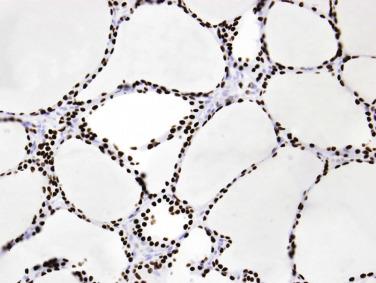
As with tumors in other endocrine organs, the presence of nuclear atypia in a thyroid tumor is not necessarily synonymous with a diagnosis of malignancy. In fact, atypical hyperchromatic nuclei in an endocrine organ are more often a reflection of hyperstimulation or degenerative change than presence of a malignant potential. For example, in Hashimoto thyroiditis and dyshormonogenesis, isolated cells with pleomorphic nuclei are very common.
In this chapter, papillary carcinoma is discussed before other tumor types because it has a precise definition based on the cytologic features, and a diagnosis of follicular neoplasm is made only in the absence of the cytologic features of papillary carcinoma. Since follicular adenoma and follicular carcinoma are closely related entities between which the pathologist must make a distinction, it is only logical to discuss them together. Although some clinical studies lump papillary carcinoma and follicular carcinoma under one category of differentiated thyroid carcinoma, this is not advisable because they are clinically, histologically, and biologically distinct entities ( Table 18A.4 ).
| Papillary Carcinoma | Follicular Carcinoma | |
|---|---|---|
| Incidence | Much commoner (>80% of all thyroid cancers) | Less common (<10% of all thyroid cancers) |
| Sex | Female predominance (M:F ratio 1 : 2.5) | Female predominance (M:F ratio 1 : 2.5–1 : 4) |
| Age | Wide age range, mean 43 years | Minimally invasive and encapsulated angioinvasive type: mean 48 years. Widely invasive type: mean 55 years |
| Presentation | Slow-growing thyroid mass; incidental finding; cervical lymph node metastasis | Slow-growing thyroid nodule; less commonly, presenting with fast-growing thyroid mass or distant metastasis |
| Gross appearance | Usually infiltrative, firm, with a granular texture | Encapsulated fleshy mass. Widely invasive types show invasive growth and satellite nodules. |
| Localization within thyroid | Multifocal disease common (20%–87.5%) | Usually unifocal |
| Basis of histologic diagnosis | Typical nuclear features (overlapping ground-glass/grooved nuclei with pseudoinclusions). Demonstration of invasion is not a prerequisite for diagnosis. a | Capsular and/or vascular invasion must be present in the follicular neoplasm, which lacks the nuclear features of papillary carcinoma. |
| Mode of spread | Locally invasive. Lymphatic spread, with lymph node metastasis in ~40% of cases. Distant metastasis is rare, mostly to the lungs if it occurs. | Low tendency for local spread beyond the thyroid capsule except widely invasive type. Lymph node metastasis is uncommon. Spreads mainly by blood, with bone and lungs being the sites of predilection. |
| Behavior | Indolent; late relapses can occur. Cancer-related mortality only 6.5% on long-term follow-up. | Cumulative mortality: 3% for minimally invasive type, 32% for widely invasive type |
| Molecular pathogenesis |
|
|
a Exception is NIFTP (see Box 18A.3 ): An encapsulated follicular-patterned neoplasm with nuclear features of papillary carcinoma, but lacking invasion and papillae is currently diagnosed as NIFTP.
Papillary carcinoma is defined as a malignant epithelial tumor showing evidence of follicular cell differentiation and a set of distinctive nuclear features. That is, the key to diagnosis is the nuclear characteristics (detailed later), and invasive growth is not required.
Papillary carcinoma can affect any age group, with female predominance (see Table 18A.4 ). Most patients present with a painless thyroid or neck mass; however, some present initially with lymph node metastasis, and the occult primary tumor in the thyroid is almost always found on the ipsilateral side ( Fig. 18A.2 ). Cystic metastases are particularly problematic because they may be mistaken for branchial cysts or benign cysts clinically or histologically ( Fig. 18A.3 ). Rare cases of papillary carcinoma arise in the thyroglossal duct, usually as an incidental finding.

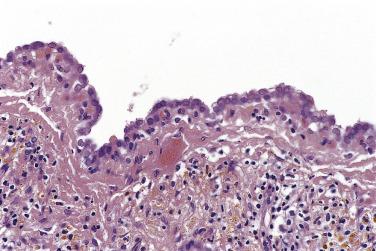
Previous irradiation to the head and neck region, radiation exposure from nuclear accident (such as the Chernobyl accident) or atomic bomb (such as survivors of the atomic bomb explosion from Hiroshima), or Hashimoto thyroiditis increases the risk for papillary carcinoma. Some syndromes also predispose to the development of papillary carcinoma (see Table 18A.2 ).
Papillary carcinoma is an indolent neoplasm with an excellent long-term prognosis. Its natural history is depicted in Fig. 18A.4 . According to the long-term follow-up study from the Mayo Clinic, the cancer-related mortality is only 6.5%. Papillary carcinoma shows a propensity to invade locally (the thyroid parenchyma, perithyroidal soft tissues, and rarely the trachea) and to metastasize to regional lymph nodes (the sites of predilection being cervicocentral and ipsilateral cervicolateral nodes). Local recurrence in the residual thyroid, soft tissues of the neck, or cervical lymph nodes can occur after treatment. Distant metastasis is uncommon (9%–14%) and generally occurs late in the course of the disease. Relapses may be delayed 20 to 30 years after the initial diagnosis.
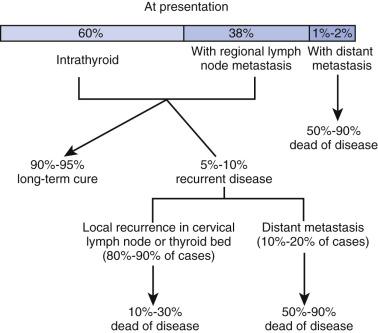
Risk assignment systems, including the American Thyroid Association management guidelines, may help guide treatment ( Fig. 18A.5 ). Total thyroidectomy has traditionally been the recommended treatment on grounds of a high frequency of tumor multifocality, but many studies have shown hemithyroidectomy or lobectomy to yield identical results for low-risk patients with no residual gross tumor. The role of postoperative radioactive iodine therapy is also controversial. Nonetheless, for high-risk patients, the standard treatment includes total thyroidectomy, radioactive iodine, and suppressive thyroxine. Lymphadenectomy is required when there is nodal metastasis and is probably worthwhile for tumor with extrathyroidal extension. The value of sentinel node dissection and prophylactic central compartment node dissection remains to be determined.
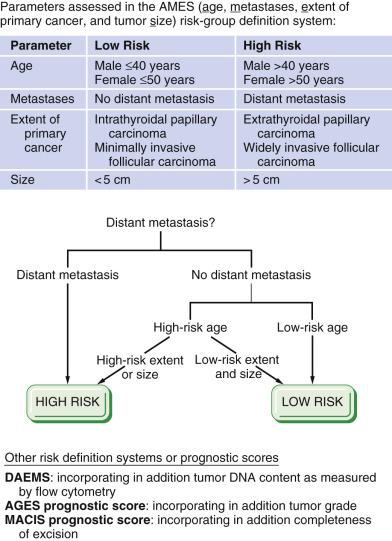
Papillary carcinomas are usually infiltrative, with irregular, ill-defined borders and a hard consistency ( Fig. 18A.6 ). They are white to tan and have a granular texture due to the presence of papillae ( Fig. 18A.7 ). The cut surfaces may be gritty because of the presence of psammoma bodies and calcifications. Multifocal disease is common (up to 65%); the multiple tumor nodules have been shown by molecular analysis to be either clonally unrelated (multicentric origin) or clonally identical (intrathyroid spread from an originally single tumor mass). Some tumors are circumscribed or encapsulated and can be grossly indistinguishable from a follicular adenoma.
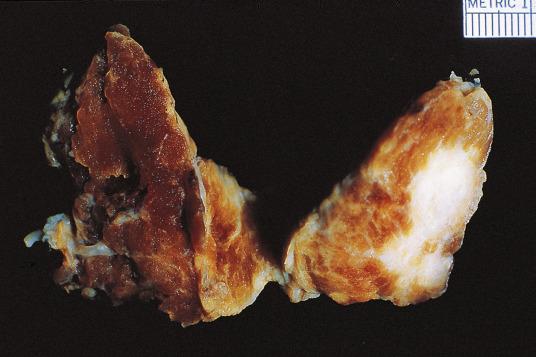
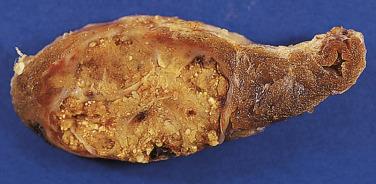
The nuclei of papillary carcinoma are typically large, crowded, ovoid, ground glass–like (“Orphan Annie” eye) and grooved, with small distinct nucleoli. The cellular crowding results in an up-and-down placement of the nuclei ( Fig. 18A.8 ). Sometimes the nuclei may assume a crescent shape (see Fig. 18A.8A ).

Ground-glass change refers to the empty-looking nuclei with scanty, marginated dusty chromatin (see Fig. 18A.8B ), believed to be an artifact of formalin fixation because it is usually not evident in frozen sections or cytologic preparations. While this feature is observed in paraffin sections in more than 80% of papillary carcinomas, it is not pathognomonic because benign lesions such as nodular hyperplasia, follicular adenoma, Graves disease, and Hashimoto thyroiditis can exhibit clear nuclei focally.
Another characteristic feature is the nuclear groove formed by deep folding of the nuclear membrane (see Fig. 18A.8B ), observed in almost all cases of papillary carcinoma, at least focally. The grooved nuclei can be well appreciated in cytologic preparations. However, nuclear grooving can also be observed in solid cell nests, some follicular neoplasms (especially Hurthle cell type), hyalinizing trabecular adenomas, poorly differentiated thyroid carcinomas, and adenocarcinomas of nonthyroid origin.
Nuclear pseudoinclusions, which represent intranuclear herniation of pockets of cytoplasm, appear as pale-staining membrane-delineated vacuoles. They are typical but not pathognomonic of papillary carcinoma and are usually found in only a minority of the tumor cells (see Fig. 18A.8A ).
In some papillary carcinomas, the nuclear features as described here are not well developed or occur only focally. The nuclei may not be ground glass but are simply pale or show evenly distributed fine chromatin. Occasionally, the nuclei may even exhibit coarse chromatin and considerable pleomorphism. In such cases, the diagnosis of papillary carcinoma would have to rest more on the architectural features and presence of more diagnostic nuclear features in other areas.
Mitotic figures are generally absent or sparse, but they can be more easily found in some highly invasive tumors or recurrences.
The neoplastic cells are polygonal to cuboidal but can be attenuated, dome-shaped, hobnailed, or columnar. The cytoplasm is lightly eosinophilic to amphophilic but can be oncocytic or clear (see Fig. 18A.8 ). Cytoplasmic mucin can sometimes be demonstrated ( Fig. 18A.9 ). Squamous differentiation occurs in approximately half of the cases and is accompanied by loss of the typical nuclear features of papillary carcinoma ( Fig. 18A.10 ).
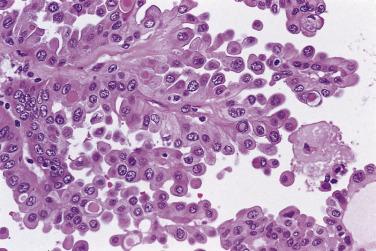
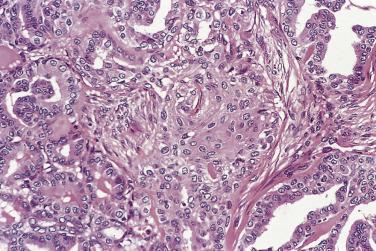
Papillary carcinomas are usually infiltrative ( Fig. 18A.11 ), but some may be circumscribed or encapsulated. Some tumors can exhibit cystic change, a feature which is particularly common in the metastatic deposits in lymph nodes (see Fig. 18A.3 ). Lymphatic permeation is not uncommon.
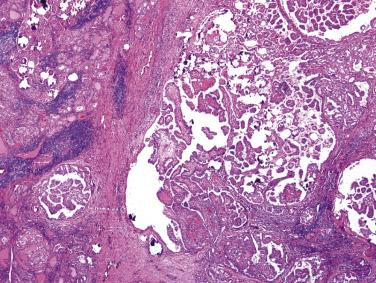
The papillae usually are arborizing ( Fig. 18A.12 ), with delicate fibrovascular cores. However, the papillae can be broad, with the cores being formed by fibrocellular, edematous, or hyalinized tissue, which may contain foamy macrophages, adipose cells, or small neoplastic follicles (see Fig. 18A.12B ). Sometimes micropapillae comprising cellular tufts are formed (see Fig. 18A.9 ).
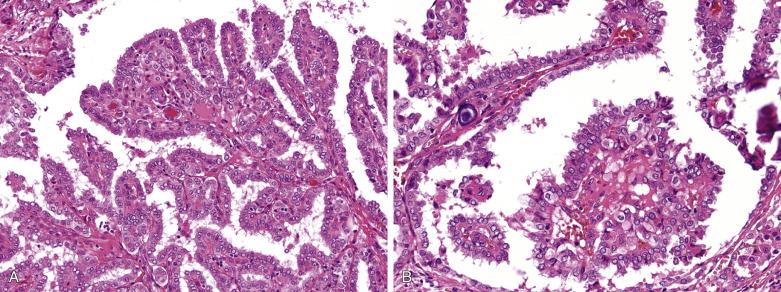
Follicles are frequently present. They vary in size and contour but are commonly elongated or irregular shaped and contain dark-staining colloid ( Fig. 18A.13 ). Some follicles can be distended with colloid. Intrafollicular hemorrhage is common. Very often there is an intricate blending of the follicles with papillae, resulting in a complex tubulopapillary pattern (see Fig. 18A.13B ). Less common patterns include microglandular, garland-like, cribriform, anastomosing tubular, trabecular, and solid ( Fig. 18A.14 ).
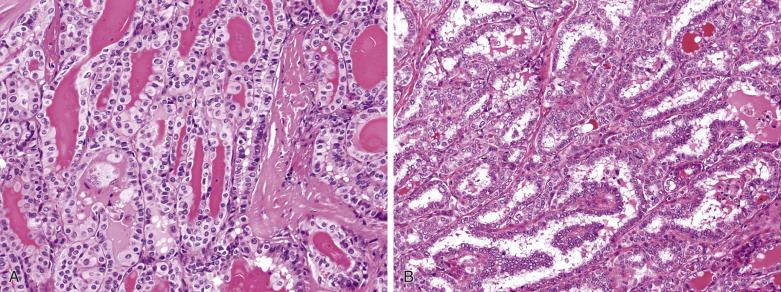
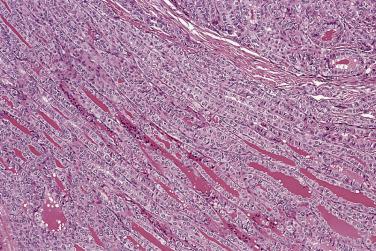
Papillary carcinoma is frequently accompanied by an abundant sclerotic stroma, which may show calcification or ossification (see Fig. 18A.11 ). Cellular desmoplastic stroma can be present at the invasive fronts. There is commonly a patchy infiltrate of lymphocytes, plasma cells, and macrophages.
Multinucleated histiocytes, often with dark-staining cytoplasm, are present in the luminal space of some follicles and papillae in 46% of cases (see Fig. 18A.8B ). They can be of diagnostic value because they are rare in benign lesions and other tumor types.
Psammoma bodies, which are laminated calcified structures, are found in approximately half of the cases. They occur in the stalks of the papillae, fibrous stroma, or among the tumor cells (see Fig. 18A.12A ). In the thyroid, they are practically pathognomonic of papillary carcinoma. Whenever psammoma bodies are identified, a diligent search must be made for papillary carcinoma. Calcified colloid materials, which are fairly common in Hurthle cell neoplasms and hyalinizing trabecular adenoma, are distinguishable from psammoma bodies by their exclusive location in the follicular lumens.
Many variants of papillary carcinoma have been described. These variants are not mutually exclusive, since a single tumor may fit the descriptions of more than one variant. Most are merely morphologic variants with no prognostic significance. The tall cell, columnar cell, diffuse sclerosing, diffuse follicular, solid/trabecular, hobnail, micropapillary, and dedifferentiated variants are biologically more aggressive, while the encapsulated variant is associated with a favorable prognosis.
This variant is composed entirely of follicles. The follicles vary in size and shape but are often elongated or irregular shaped, with abortive papillary formation, and the colloid is usually deep staining and scalloped ( Fig. 18A.15 ). Psammoma bodies and sclerosis may be present. The diagnosis rests on identification of the typical nuclear features of papillary carcinoma.
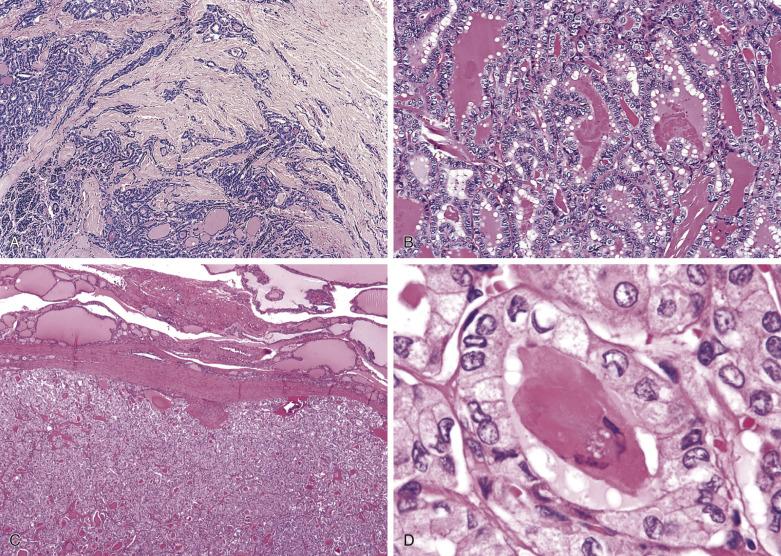
This variant has evoked intense controversies, in particular the highly variable threshold in histologic diagnosis, the low interobserver reproducibility in diagnosis, and its biologic nature. However, it is now clear that follicular variant of papillary carcinoma encompasses two entities: infiltrative type and encapsulated type ( Table 18A.5 ).
| Infiltrative (Nonencapsulated) Type (n = 17) |
Encapsulated Type +/- Capsular or Vascular Invasion a (n = 61) |
|
|---|---|---|
| Marked intratumoral fibrosis | 88% | 18% |
| Extrathyroidal extension | 65% | 5% |
| Positive margin | 50% | 2% |
| Lymph node metastasis | 65% | 5% (0% for noninvasive group) |
| Distant metastasis | 0% | 0% |
| Molecular alterations | BRAF mutation, RET/PTC translocation; occasionally RAS mutation | RAS mutation, PAX8/PPARγ translocation |
| Clinical outcome | 0% with adverse event | Noninvasive: 0% with adverse event Invasive: 1/13 (8%) developed cervical lymph node recurrence |
a The noninvasive form is currently categorized as noninvasive follicular thyroid neoplasm with papillary-like nuclear features .
The infiltrative type shows obvious infiltration of the thyroid parenchyma, often accompanied by sclerosis, similar to conventional papillary carcinoma, except that papillae are absent. For this type, there should be no difficulty in recognizing its malignant nature, and the interobserver reproducibility in diagnosis is high. The clinicopathologic and biologic features are no different from classic papillary carcinoma (see Table 18A.5 and Fig. 18A.15 ).
The clinical features (low frequency of lymph node metastasis and lack of adverse events in the absence of invasion), pathologic features (encapsulated solitary tumor and infrequent intratumoral sclerosis), and molecular features (presence of RAS mutation or PAX8/PPARγ translocation, but not BRAF mutation or RET/PTC translocation) of the encapsulated type are much more akin to follicular adenoma/carcinoma ( Table 18A.6 ; also see Table 18A.5 ). In the 2017 WHO classification, the designation invasive encapsulated follicular variant of papillary carcinoma is reserved for cases that exhibit capsular or vascular invasion (see Fig. 18A.15C and D ), while cases lacking invasion are categorized as noninvasive follicular thyroid neoplasm with papillary-like nuclear features or NIFTP .
| Follicular Adenoma or Carcinoma | Conventional Papillary Carcinoma | FOLLICULAR VARIANT OF PAPILLARY CARCINOMA | ||
|---|---|---|---|---|
| Infiltrative | Encapsulated a | |||
| RET/PTC translocation | 0% | 20% | 11% | 0% |
| BRAF mutation | 0% | >50% (V600E) | 26% | 0% |
| RAS mutation | Follicular adenoma 20%–40% Follicular carcinoma 30%–50% |
0% | 11% | 36% |
| PAX8/PPARγ translocation | Follicular adenoma 10% Follicular carcinoma 50% |
0% | 0% | 4% |
a The noninvasive encapsulated form is currently categorized as noninvasive follicular thyroid neoplasm with papillary-like nuclear features .
This variant constitutes 4% to 14% of all papillary carcinomas. The fibrous capsule may or may not show invasion by tumor ( Fig. 18A.16 ), but lymph node metastasis can occur even in the absence of capsular or vascular invasion. The patients tend to be younger, compression symptoms are most uncommon, and the frequency of lymph node metastasis (12%–38%) is lower compared with conventional papillary carcinoma. The prognosis is excellent, with all patients remaining disease free after treatment. According to one series comparing encapsulated classic papillary carcinoma (comprising papillae or a mixture of papillae and follicles) with encapsulated follicular variant of papillary carcinoma, the former is more likely to show capsular invasion (65% vs 38%), less likely to show vascular invasion (5% vs 25%), and more likely to show lymph node metastasis (26% vs 3%). The findings indicate that the encapsulated follicular variant of papillary carcinoma behaves more like follicular adenoma or carcinoma; cases lacking invasion are recategorized as NIFTP in the 2017 WHO classification.
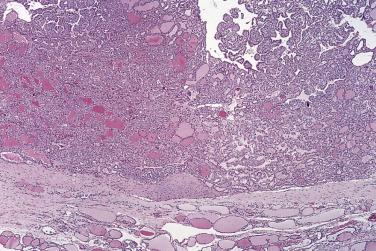
This variant is defined by presence of more than 50% to 70% areas exhibiting solid, packeted or trabecular growth. The tumor is often traversed by delicate capillaries, and the nuclear features of conventional papillary carcinoma are retained ( Fig. 18A.17 ). There should not be tumor necrosis. This variant occurs with a disproportionate frequency among nuclear accident-associated papillary thyroid carcinomas. The tumor is often large and shows extrathyroidal extension. It is associated with a higher frequency of pulmonary metastasis and less favorable prognosis compared with conventional papillary carcinoma. It is most important not to mistake this variant for poorly differentiated thyroid carcinoma (in which nuclei are more hyperchromatic and mitotic figures more readily identified).
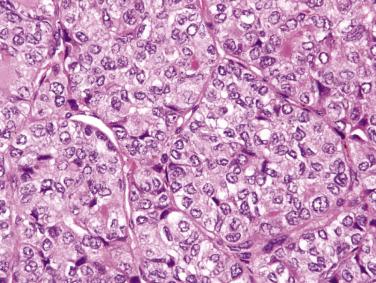
This variant mostly affects children and young adults, who present with unilateral or bilateral symmetric thyroid swelling. Tests for serum antithyroglobulin or antimicrosomal antibodies may be positive, increasing the mimicry of thyroiditis. Most studies have shown this variant to be biologically more aggressive than conventional papillary carcinoma, as manifest by a higher incidence of extrathyroidal extension, lymph node metastasis (nearly 100%), and frequent distant metastasis. There is a high recurrence rate. Most studies report a low mortality rate, presumably related to the favorable impact of young age, but some have reported a worse 5-year survival (87.5%) compared with conventional papillary carcinoma.
The thyroid shows diffuse replacement of the parenchyma by white firm tissue, which is often gritty on cutting. The typical histologic features include :
Diffuse involvement of one or both lobes ( Fig. 18A.18A )

Sclerosis
Heavy lymphoplasmacytic infiltrate
Abundant psammoma bodies
Scattered small islands of papillary carcinoma with prominent squamous or squamoid differentiation (see Fig. 18A.18B ), although a discrete tumor can sometimes be found in addition
Extensive lymphatic permeation
On casual examination, the histologic picture may mimic that of thyroiditis, but the psammoma bodies should provide a strong clue to the diagnosis of papillary carcinoma. Loss of the characteristic nuclear features of papillary carcinoma in the areas of squamous differentiation further increases the difficulties in diagnosis.
This is a rare aggressive form of papillary carcinoma occurring in young patients (mean age 21.3 years), characterized by diffuse involvement of the entire thyroid without formation of discernible nodules, exclusive or predominant follicular pattern, and absence of fibrosis. Since the follicles are often large or even cystic, distinction from colloid-adenomatous goiter may be difficult ( Fig. 18A.19 ). Careful attention to nuclear details, in particular in the smaller follicles, and clinical features (such as evidence of metastatic disease) is required for making the diagnosis. The diffuse follicular variant shows a high frequency of lymph node (87.5%), pulmonary (75%), and bone (25%) metastasis. However, the outcome is still favorable because of the excellent response to radioactive iodine therapy and the favorable impact of young age.
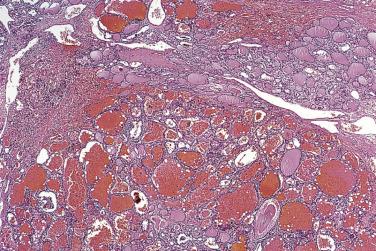
This variant is composed predominantly of cells that are two to three times as tall as they are wide, and accounting for 30% or more of the tumor ( Fig. 18A.20 ). Compared with conventional papillary carcinoma, the tall cell variant shows the following features a
a References .
:
Slightly older age group (mean 50–57 years)
More bulky tumors
Higher frequency of BRAF mutation (60%–95%)
Frequent nodal metastasis (67%)
Frequent extrathyroidal extension (42%–82%)
More aggressive (recurrence in 18%–58%; mortality 9%–25%)
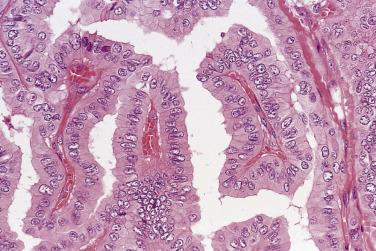
Nonetheless, there are studies that have shown the tall cell variant not to differ in behavior from conventional papillary carcinoma except for a higher rate of extrathyroidal extension. Some cases can dedifferentiate into a spindle cell squamous or anaplastic carcinoma.
The tall cell variant is usually highly papilliferous and invasive. The nuclei, which are typical of those of papillary carcinoma, are mostly basally located. The cytoplasm is often plentiful and oncocytic due to accumulation of mitochondria. Focal clearing of the cytoplasm, particularly subnuclear, is sometimes observed. The tall cell variant has to be distinguished from the columnar cell variant (see next section).
The columnar cell variant was first reported by Evans as a rare thyroid neoplasm (columnar cell carcinoma) that was much more aggressive than the differentiated thyroid carcinomas. Subsequent studies, however, have shown that only cases showing obvious invasive growth pursue an aggressive course, while the encapsulated ones have a favorable prognosis.
For tumors that are invasive, there is male predilection, with a mean age of 57 years. There is a high frequency of distant metastases (especially to lung and vertebra) and regional lymph node metastases. The tumor-associated mortality rate is high (>50%).
On the other hand, for encapsulated tumors, there is marked female predominance. The mean age is 43.8 years, and no patients died from the tumor.
Tumors that are invasive often show extrathyroidal extension. The encapsulated tumors may show capsular, and sometimes vascular, invasion. The columnar cell variant of papillary carcinoma is characterized by mixed papillary, complex glandular, cribriform, and solid patterns ( Fig. 18A.21 ). The papillae and glands are lined by tall columnar cells with pseudostratified hyperchromatic oval or elongated nuclei (see Fig. 18A.21 ). Subnuclear vacuoles and cytoplasmic clearing may be present ( Fig. 18A.22 ). The cells in the solid areas are often smaller and polygonal. Fascicles of spindle cells can also be present. The tumor is positive for thyroid transcription factor 1 (TTF1), and 10% to 50% of cases are positive for CDX2. BRAF mutation is demonstrable in 10% to 33% of cases.

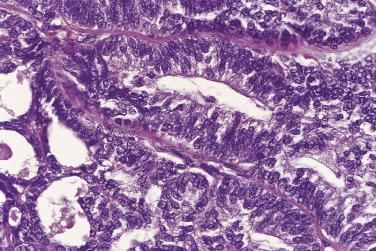
The columnar variant differs from the tall cell variant in the greater height of the cells, striking nuclear pseudostratification and nuclear hyperchromasia, and lack of oncocytic change in the cytoplasm. Stated simply, columnar cell carcinoma is histologically reminiscent of colorectal carcinoma or endometrioid adenocarcinoma, while tall cell papillary carcinoma looks more like conventional papillary carcinoma.
Occasional cases show coexistence and merging with tall cell papillary carcinoma. b
b References .
There is some morphologic overlap with the cribriform-morular variant of papillary carcinoma and familial adenomatous polyposis (FAP)–associated thyroid carcinoma. In fact, one case reported by Evans as occurring in a patient with FAP probably represents such a case.
It is formed predominantly by cells with abundant eosinophilic granular cytoplasm due to accumulation of mitochondria ( Fig. 18A.23 ). There may be partial or total cytoplasmic clearing caused by ballooning of the mitochondria. The nuclei are otherwise typical of papillary carcinoma, although some may show hyperchromasia and distinct nucleoli. The behavior and molecular features are no different from conventional papillary carcinoma. It is important to distinguish this neoplasm from Hurthle cell neoplasms.
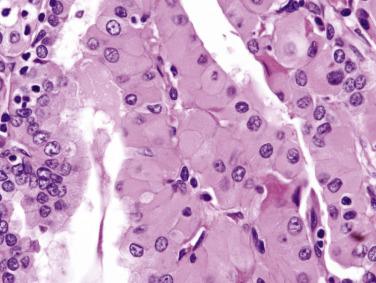
Rare cases of papillary carcinoma resemble Warthin tumor of the salivary gland by virtue of a papillary pattern and a rich lymphoplasmacytic infiltrate in the cores of the papillae. The cells that cover the papillae have an oncocytic appearance and can be tall ( Fig. 18A.24 ). This variant often occurs in a background of Hashimoto thyroiditis, and immunoglobulin G4 (IgG4) + plasma cells may be increased.

Rare cases of papillary carcinoma exhibit extensive cytoplasmic clearing, usually due to accumulation of glycogen. In those cases with admixed oncocytic tumor cells, the clear cell change may be confined to the apical portion of the cells and results from ballooning of mitochondria.
This refers to tumors with more than a 50% area composed of large follicles. This variant may be mistaken for nodular goiter or macrofollicular adenoma, but attention to the nuclear features will permit the correct diagnosis to be made ( Fig. 18A.25 ). The cells that line the macrofollicles are attenuated and thus may not display the characteristic nuclear features of papillary carcinoma. Assessment is therefore best made on the smaller follicles. Uncommonly, dedifferentiation to anaplastic carcinoma can occur.
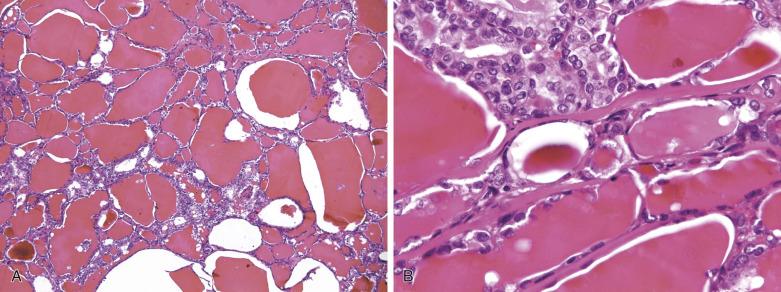
This is an uncommon variant characterized by a prominent cribriform pattern, with interspersed squamoid islands (morules) that frequently harbor nuclei filled with lightly eosinophilic, homogeneous, biotin-containing inclusions ( Fig. 18A.26 ). Closely packed follicles, papillae, and trabeculae are commonly admixed. Characteristically, the luminal spaces are devoid of colloid. The tumor cells are columnar, cuboidal, or attenuated. The nuclei are often chromatin rich, but nuclear features typical of papillary carcinoma can often be seen focally. Some tumor cells can be plump spindled, forming fascicles or whorls. The tumor is often circumscribed or even encapsulated, with or without capsular and vascular invasion. Nuclear staining for β-catenin is characteristic ( Fig. 18A.27 ). The neoplasm can potentially be mistaken for tall cell and columnar cell variants of papillary carcinoma, as well as hyalinizing trabecular adenoma/carcinoma.
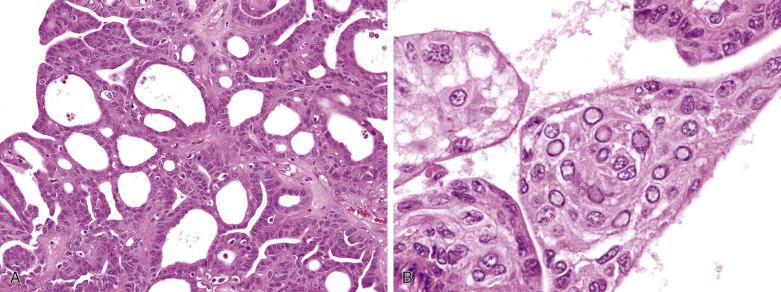
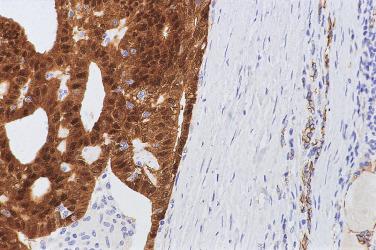
About half of all cases occur as a sporadic tumor (often solitary) and half occur in the setting of familial adenomatous polyposis (often multifocal). In fact, most thyroid carcinomas occurring in patients with familial adenomatous polyposis exhibit this histologic pattern. The implication of a diagnosis of this variant of papillary carcinoma is that the clinician should be alerted to the possible association with familial adenomatous polyposis.
The cribriform-morular variant occurs almost exclusively in females, and the mean age at diagnosis of the thyroid tumor is 24 years, sometimes predating the diagnosis of familial adenomatous polyposis. There is a low frequency of lymph node metastasis at presentation, and the clinical outcome is highly favorable.
The tumors commonly show RET/PTC rearrangement as characteristic of papillary carcinoma. The APC gene has also been implicated, either through germline mutation (sometimes accompanied by somatic mutation) in familial adenomatous polyposis-associated cases or somatic mutation in some sporadic cases. Somatic mutations in CTNNB1 (β-catenin gene) and PIK3CA are common, while BRAF mutation is not found.
In rare cases, adipose cells are interspersed within the papillary carcinoma.
Rarely, papillary carcinoma is associated with such an abundant nodular fasciitis or fibromatosis-like stroma that the neoplastic nature of the lesion may be obscured ( Fig. 18A.28A ). The interaction between the stroma and tumor results in unusual histologic patterns reminiscent of fibroadenoma, phyllodes tumor, or fibrocystic disease of the breast. The tumor islands can also be dispersed and subtle. The stroma is composed of spindled myofibroblastic cells lying in a vascularized fibromyxoid matrix, with extravasated red cells (see Fig. 18A.28B ). The spindle cells have been postulated to represent an exaggerated stromal reaction to the infiltrative neoplasm, but recent studies suggest that they represent desmoid fibromatosis as evidenced by nuclear staining for β-catenin (and hence the proposed revised terminology of papillary carcinoma with desmoid-type fibromatosis ). However, CTNNB1 (β-catenin) gene mutation has been found in only 3 of 10 cases.

Rare examples of papillary carcinoma can exhibit a component of spindle tumor cells, which can constitute a minor to major proportion of the entire tumor. The bland-looking spindle cells form short fascicles and merge into the papillary carcinoma component. They are epithelial in nature, and they stain for both cytokeratin and TTF1.
This is a rare aggressive variant in which more than 30% of the tumor cells exhibit hobnail and/or micropapillary features. Cervical lymphadenopathy is common at presentation. During the course of disease, distant metastases are common. According to one series, 6 of 12 patients died of disease after a mean of 45 months. The tumor is usually multifocal, with variably sized papillae covered by cells with apically placed nuclei that produce a surface bulge ( Fig. 18A.29 ). BRAF and TP53 mutations are detected in 58% to 80% and 17% to 56% of cases, respectively.

Rare cases of papillary carcinoma may show abundant deposits of globular hyaline material in focal areas of the tumor, reminiscent of the architectural features of adenoid cystic carcinoma. This morphologic feature apparently does not define a specific subtype of papillary carcinoma but can be seen in usual papillary carcinoma, follicular variant, columnar variant, and cribriform-morular variant.
This refers to the coexistence of papillary carcinoma with an anaplastic or poorly differentiated thyroid carcinoma ( Fig. 18A.30 ). The latter component may appear at presentation of the papillary carcinoma or with subsequent recurrence. The transformation can occur either in the primary tumor or in metastatic deposits. The prognosis is bad because it is dictated by the higher-grade component, except when the dedifferentiated component constitutes only a tiny focus of the entire tumor.
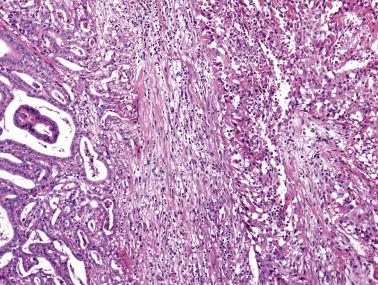
Papillary microcarcinoma is defined as a papillary thyroid carcinoma measuring 1 cm in diameter or less. It may be incidental (incidental finding on histologic examination of thyroid specimen from surgery for benign disease or autopsy) or nonincidental (diagnosed on clinical grounds, such as detection by ultrasound examination of thyroid or presentation with cervical nodal metastasis). Small tumors merit recognition because of their excellent prognosis, even though lymph node metastasis and rarely distant metastasis can occur. According to a series of 90 cases of thyroid microcarcinoma, all patients have remained well at a mean follow-up of 17.3 years, even though some patients had cervical lymph node metastasis at presentation. Risk factors for lymph node recurrences are nonincidental type, nodal metastases at presentation, young age (<45 years), size larger than 7 mm, multifocality, subcapsular tumor localization, and extrathyroidal extension. The rare patients who have an unfavorable outcome are those with lymphadenopathy larger than 3 cm and a nonencapsulated type of primary lesion.
Incidentally discovered (“occult” or “occult sclerosing”) papillary carcinomas, which are almost always microcarcinomas, have been reported to show highly variable prevalence rates in different countries, the highest rates having been reported in Finland (35.6%) and Japan (17.9%–28.4%) and the lowest in Switzerland (1.2%). Most studies report figures in the region of 5% to 10%. The wide-ranging figures may be attributable to differences in diagnostic criteria and techniques of examination, but a genetic factor is probably also responsible. Most incidental papillary carcinomas appear after puberty, and the prevalence does not increase with age thereafter. Therefore it appears that the vast majority of these incidental tumors remain dormant and do not grow to clinically apparent disease. Furthermore, the lack of female predominance and the dissociation between the prevalence rates of incidental and clinical thyroid carcinomas in various countries suggest that incidental papillary carcinomas are biologically different from the clinically manifest papillary carcinomas. No additional therapy is required if it represents an incidental finding in surgical specimens, be it a lobectomy or thyroidectomy. In view of the excellent prognosis and to avoid overtreatment, the Porto proposal suggested renaming the entity as papillary microtumor to take away the connotation of malignancy.
Most incidentally discovered papillary carcinomas are predominantly follicular in architecture. The most common type is invasive and often associated with sclerosis, producing a stellate configuration ( Fig. 18A.31 ). A histologic mimicker is multifocal fibrosing thyroiditis, which shows similar configuration but lack of nuclear features of papillary carcinoma. The other type is circumscribed, with aggregates of neoplastic follicles apparently in harmony with, but morphologically distinct from, the surrounding follicles; there is minimal or no sclerosis ( Fig. 18A.32 ). Rare examples are encapsulated (see Fig. 18A.31B ). These microcarcinomas are sometimes multifocal in the same lobe (23%) and may involve the other lobe (17%). Regional lymph node metastasis can occur (16%) but is again often microscopic and probably remains dormant even without excision.

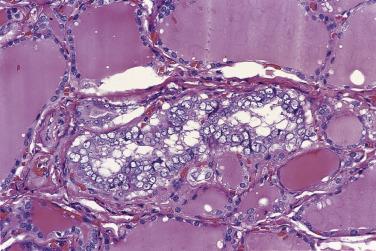
Papillary carcinoma typically stains for pancytokeratin, thyroglobulin, TTF1, and PAX8, but not neuroendocrine markers (see Table 18A.4 ). In areas of squamous differentiation, thyroglobulin and TTF1 staining are usually lost. Immunostaining for thyroglobulin is helpful for confirming the thyroid origin of a metastatic carcinoma of unknown primary and in supporting a diagnosis of cystic metastasis of papillary thyroid carcinoma in lymph node versus a benign cyst.
Expression of a variety of markers, such as high molecular weight cytokeratin (34βE12, CK1), CK19, galectin-3, mesothelium-associated antibody HBME1, Leu7 (CD57), CITED1, fibronectin-1, CD15 (LeuM1), CD44, or platelet-derived growth factor has been suggested to be of value in diagnosis of papillary carcinoma versus benign thyroid lesions or other thyroid tumors, but the staining can be patchy and weak even in classic papillary carcinoma ( Fig. 18A.33 ). Furthermore, normal thyroid follicles, nonneoplastic thyroid lesions (in particular thyroiditis), and benign thyroid tumors can exhibit focal or extensive staining for many of these markers ( Fig. 18A.34 ). For example, the popular markers CK19 and galectin-3 are positive in 31% and 55% of cases of adenomatous hyperplasia, respectively. Even the application of a panel of antibodies (such as CK19, galectin-3, and HBME1) results in only marginal improvement in performance. CD56 has emerged as a helpful marker in diagnosis—its expression is lost in most cases of papillary carcinoma, but rarely in normal thyroid, benign thyroid lesions, and other thyroid carcinomas.
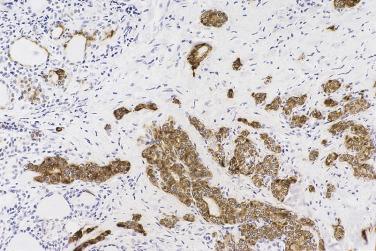

Two mutually exclusive molecular alterations are found in most papillary carcinomas, and both result in activation of the mitogen-activated protein kinase (MAPK) pathway. Tumors featuring the different molecular alterations are associated with similar but distinct gene expression profiles.
This occurs in 10% to 30% of cases. The frequency of RET/PTC rearrangements has dropped over the past 15 years (from 33% to 10% according to a study from Italy). Of interest, transfection of primary cultures of human thyroid cells with a RET/PTC retroviral construct results in nuclear changes, including irregular nuclear contour and euchromatic appearance, suggesting that the genetic alteration may underlie the observed nuclear features characteristic of papillary carcinoma. Oligoclonal RET/PTC rearrangement can be found in nonneoplastic thyroid tissues such as Hashimoto thyroiditis and benign nodules.
The tyrosine kinase region of RET gene can be fused with a number of genes constitutively expressed in thyroid epithelial cells, such as PTC1 through inv(10)(q11.2q21) , PTC2 through t(10;17)(q11.2;q23), PTC3 through cytogenetically undetectable paracentric inversion within 10q11.2, PTC4, and PTC5 . The fusion contributes a dimerization domain to the RET protein, leading to constitutive activation of the tyrosine kinase. The frequency of RET/PTC gene fusion is higher among children and young patients (50%–60%), Chernobyl accident–associated papillary carcinomas (60%–80%, most commonly RET/PTC3 ), and patients who had received external radiation therapy during childhood (60%–70%, most commonly RET/PTC1 ). RET/PTC fusion is also correlated with locally advanced disease, lymph node metastasis, low proliferative activity, and low tendency for dedifferentiation. RET/PTC1 is correlated with papillary carcinoma with predominant papillary architecture and papillary microcarcinoma, and RET/PTC3 the tall cell and solid variants. RET/PTC fusion is not found in follicular adenoma/carcinoma, poorly differentiated thyroid carcinoma, or anaplastic carcinoma.
Less commonly, NTRK1 gene, which encodes a receptor for the nerve growth factor, is fused with TPM3, TPR, or TFG. NTRK3 can be fused with ETV6 or other genes; ETV6-NTRK3 is one of the most common oncogenic rearrangements in radiation-associated papillary thyroid carcinomas. ETV6-NTRK3 positive papillary carcinomas occurring in adults without radiation exposure are locoregionally aggressive and can metastasize distantly.
ALK gene translocation (most commonly STRN-ALK ) occurs in 2.2% of papillary carcinomas, and is more common in young females, diffuse sclerosing variant, and radiation-related tumor. Its occurrence is mutually exclusive with BRAF mutation and is not associated with aggressive clinicopathologic features.
BRAF belongs to the RAF family of protein kinases that play a central role in transduction of signals along the RAS/RAF/MEK/MAPK pathway, mediating cell growth, differentiation, and survival. BRAF mutation, which causes constitutive activation of BRAF kinase, occurs in approximately 50% of cases and up to 88% in some series. The most common mutation is a missense mutation at nucleotide 1799, with T→A transversion that results in substitution of valine by glutamic acid (V600E mutation). Interestingly, the frequency of BRAF V600E mutation in papillary carcinoma has gradually increased over the past 20 years (e.g., from 28% to 58% in a study from Italy and from 51% to 88% in a study from the United States). BRAF V600E mutation is much less frequent in papillary carcinomas of children and young patients (0%–13%). BRAF mutation is more prevalent in classic papillary carcinoma, tall cell variant, Warthin tumorlike variant, and oncocytic variant, but is very rare in the follicular variant. The prognostic significance of BRAF mutation is controversial, but most studies report this feature to be correlated with aggressive features such as older age, extrathyroidal extension, more advanced stage (III and IV), lymph node metastasis, and tumor recurrence, BRAF mutation can be detected in one-third to one-half of cases of anaplastic carcinoma and 0% to 13% of poorly differentiated thyroid carcinoma; however, it is absent in follicular adenoma/carcinoma and medullary carcinoma. Thus at least some cases of anaplastic carcinoma appear to have transformed from papillary carcinoma.
Mutation of the RAS gene is very rare in papillary carcinomas. The previously reported 15% prevalence is attributable to inclusion of the encapsulated follicular variant of papillary carcinomas, most cases of which are now reclassified as NIFTP. TERT promoter mutations are found in 5% to 15% of cases and are associated with a worse prognosis.
Among the various prognostic factors in papillary carcinoma, the most important ones are age, tumor size, and stage. Applying a risk-group model on 810 patients with papillary carcinoma, with a median follow-up of 20 years, the survival rates of the low-risk (n=403), intermediate-risk (n=313), and high-risk (n=94) groups are 99%, 83%, and 43%, respectively.
Age. Mortality is very low in patients under the age of 40 years. c
c References .
Sex. Most studies report the male sex to be associated with a worse prognosis, but the gender difference is no longer observed for tumors diagnosed at ages greater than 55 years.
Size of tumor. Risks of recurrence, distant metastasis, or death from papillary carcinoma increase progressively with the size of the primary tumor. The prognosis of tumors measuring less than 1 to 1.5 cm is excellent, while that of tumors over 4 cm is poor.
Extrathyroidal extension. Extrathyroidal extension, defined as involvement of the perithyroidal soft tissues, worsens the prognosis, although cases showing minimal (microscopic) extrathyroidal extension show comparable outcome as those without extrathyroidal disease. d
d References .
Thus microscopic extrathyroidal extension has been removed from the definition of T3 disease in the eighth edition TNM staging, and this feature no longer affects T category or overall stage. Gross extrathyroidal extension is designated pT3b or pT4a depending on structures being invaded. Invasion of the esophagus or trachea is associated with a particularly unfavorable outcome (10-year survival 63%).
The prognostic significance of lymph node metastasis is controversial, with some studies reporting lack of impact on survival and others demonstrating a negative impact. e
e References .
A meta-analysis shows that subclinical small-sized metastasis (<1 cm) in five or more lymph nodes is associated with a low recurrence risk, while clinically detectable metastasis in more than five lymph nodes with metastasis size greater than 3 cm is associated with a significant risk of recurrence.
Distant metastasis. This is associated with markedly worsened prognosis.
Tumor encapsulation. Tumor encapsulation confers a highly favorable prognosis.
Histologic variants and histologic features. The tall cell, columnar cell, diffuse sclerosing, diffuse follicular, solid, hobnail, and dedifferentiated variants are more aggressive. There is no evidence that the proportion of follicles and papillae in papillary carcinoma influences the prognosis. High histologic grade (defined by nuclear atypia, tumor necrosis, and/or vascular invasion) has been reported to be a poor prognostic factor on multivariate analysis. Marked cellular atypia (defined by multilayered cells with marked variation in cellular and nuclear size and shape, and uneven distribution of chromatin) and trabecular growth pattern have been reported to be associated with a worse prognosis.
Completeness of tumor excision. Incomplete tumor excision increases the risk of recurrence.
Molecular features. The prognostic significance of BRAF mutation is controversial, but most studies report this feature to be correlated with aggressive features. ETV6-NTRK3 tumors show more aggressive behavior. Certain molecular pathways and gene signatures can segregate patients with and without tumor-associated mortality.
Follicular adenoma and carcinoma are respectively benign and malignant epithelial tumors of the thyroid showing follicular cell differentiation but lacking the diagnostic nuclear features of papillary carcinoma.
Follicular carcinoma used to comprise 10% to 20% of all primary thyroid cancers, but its frequency has dropped to less than 5% to 10% in recent years, attributable to increased detection of early papillary carcinoma and adoption of a more liberal approach in diagnosis of follicular variant of papillary carcinoma. The incidence of follicular carcinoma is higher in areas of endemic goiter, and iodine deficiency appears to be the main contributing factor because addition of iodine supplement to the diet has been associated with a decline in the incidence of follicular carcinoma. Rarely, follicular carcinoma may arise in a preexisting follicular adenoma. Dyshormonogenesis and irradiation predispose to the development of follicular carcinoma. Rare cases of follicular neoplasms occur as part of hereditary nonmedullary thyroid cancer syndrome (see Table 18A.2 ).
Follicular adenoma occurs mostly in adults aged 20 to 50 years, but no age is exempt. It is more common in females (M:F ratio 1 : 6). Most patients present with a solitary thyroid nodule noticed for variable periods. The adenomas usually lack uptake on iodine scans (“cold” nodules), but rare ones may be “hot” and can cause hyperthyroidism (so-called toxic adenoma). They are totally benign and are adequately treated by lobectomy.
Follicular carcinoma generally affects patients with a higher mean age compared with follicular adenoma ( Table 18A.7 ; see also Table 18A.4 ). Most patients present with a thyroid mass, but up to 11% of patients present initially with distant metastasis such as bone pain, fracture, or pulsatile mass in soft tissue. In contrast to papillary carcinoma, the main mode of spread is hematogenous (predilection sites being bone and lung) rather than lymphatic. The likelihood of metastasis and survival probability depend greatly on the extent of local disease (see Table 18A.7 ). The natural history of follicular carcinoma is depicted in Fig. 18A.35 . For patients who present initially with metastasis, it can be surprisingly difficult to ascertain a diagnosis of malignancy in the subsequently excised thyroid gland—in some cases, the follicular neoplasm shows no vascular invasion and only equivocal capsular invasion.
| Minimally Invasive a | ENCAPSULATED ANGIOINVASIVE a | Widely Invasive | ||
|---|---|---|---|---|
| With Limited Vascular Invasion | With Extensive Vascular Invasion | |||
| Diagnostic criteria | Encapsulated tumor with capsular invasion only, and no vascular invasion | Encapsulated tumor with invasion of less than four blood vessels +/- capsular invasion | Encapsulated tumor with invasion of four or more blood vessels +/- capsular invasion | Tumor with widespread invasion of adjacent thyroid tissue and/or blood vessels |
| Mean age at diagnosis | Younger (47–50 years) | Younger (47–50 years) | Younger (47–54 years) | Older (53–59 years) |
| Local recurrence | No | Rare | Rare | Yes |
| Regional lymph node metastasis | No | Rare | Rare | More common (13%–24%) |
| Distant metastasis | ~0% | Rare (5%), and often delayed | Sometimes | Common (29%–69%), especially to lung, bone, brain, liver |
| Clinical outcome b | Disease-associated mortality ~0% | Excellent prognosis, with low long-term mortality (3%–5%) | Less favorable outcome, with cumulative event rate of 18%. | Unfavorable outcome, with long-term mortality of 30%–50% |
| Treatment | Lobectomy may be adequate | Lobectomy or subtotal thyroidectomy +/- suppressive dose of thyroxine | Total thyroidectomy, radioactive iodine and suppressive dose of thyroxine | Total thyroidectomy, radioactive iodine and suppressive dose of thyroxine |
a Terminology change (WHO classification 2017): Encapsulated angioinvasive follicular carcinoma was previously classified as a form of minimally invasive follicular carcinoma. The term minimally invasive follicular carcinoma is currently reserved for cases with capsular invasion only.
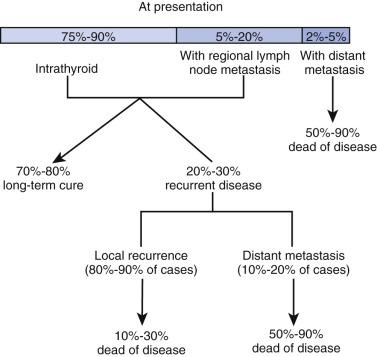
Follicular adenoma and minimally invasive/encapsulated angioinvasive follicular carcinoma are encapsulated and usually indistinguishable macroscopically, except that the capsule tends to be thicker in the latter. The size ranges from less than 1 cm to over 10 cm. It is solid, fleshy, and tan to light brown, sometimes having a glistening quality ( Fig. 18A.36 ). Secondary changes such as hemorrhage and cystic degeneration may be present. The widely invasive follicular carcinomas may lack a discrete capsule, and show, in addition, obvious invasion beyond the main tumor bulk, and tumor thrombi may be seen distending blood vessels.
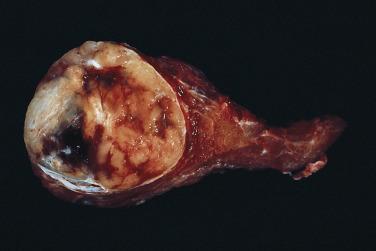
Follicular neoplasms are nearly always enveloped by a fibrous capsule, which is often much thicker in follicular carcinomas than follicular adenomas. However, for some widely invasive follicular carcinomas, a distinct capsule may be lacking. The tumors are composed of closely packed follicles, trabeculae, or solid sheets; rarely, a papillary pattern can be present focally. The tumor cells are cuboidal or low columnar and possess dark-staining or pale-staining round nuclei with inconspicuous nucleoli, although some tumors can exhibit nuclear pleomorphism ( Figs. 18A.37, 18A.38, and 18A.39 ). Scattered enlarged hyperchromatic nuclei among uniform-appearing nuclei are not uncommon. Mitoses generally are uncommon, except for some widely invasive follicular carcinomas. The cytoplasm can be eosinophilic, oncocytic, or clear.
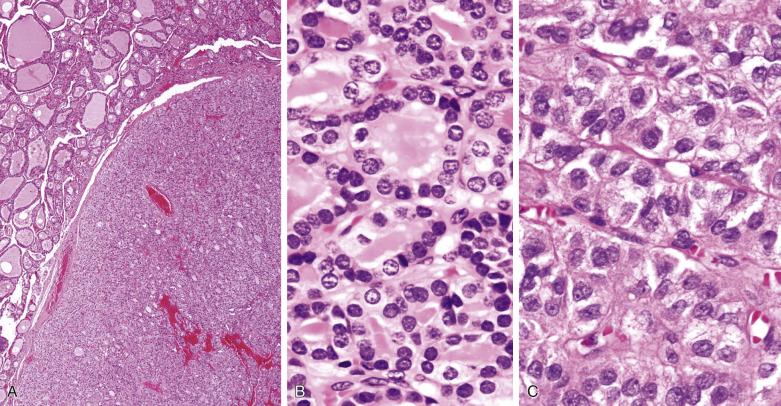
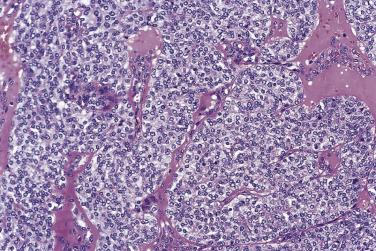
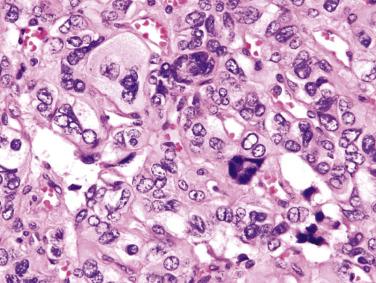
In an individual case, the histologic pattern can be uniform throughout or can vary from area to area. Neoplasms composed predominantly of large, normal-sized and small follicles are termed macrofollicular, normofollicular, and microfollicular/fetal, respectively (see Fig. 18A.37B ). Neoplasms showing a trabecular/solid pattern are termed trabecular or embryonal (see Fig. 18A.38 ).
Within the tumor, delicate capillaries are present between the follicles and cell islands, although they are not eye catching in routine histologic sections (see Fig. 18A.37A ). Secondary changes such as hemorrhage, hemosiderin deposition, sclerosis, edema, necrosis, and cystic change are not uncommon. Rarely, amyloid is present.
The metastatic deposits from follicular carcinoma are morphologically similar to the primary tumor, but they can be so deceptively bland as to mimic normal thyroid tissue ( Fig. 18A.40 ).
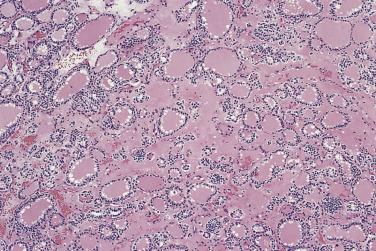
In a follicular-patterned neoplasm lacking the cytoarchitectural features of papillary carcinoma, the only feature that distinguishes a carcinoma from an adenoma is the presence of unequivocal vascular and/or capsular invasion in the former, which means that a reliable distinction between the two requires thorough examination of the tumor-thyroid interface. While presence of any of the following features should heighten the suspicion for follicular carcinoma (see Figs. 18A.37B and 18A.38 ), tumors exhibiting such features are still labeled follicular adenoma if no invasion is found after thorough sampling:
Thick fibrous capsule
High cellularity, with solid or trabecular growth pattern
Diffuse nuclear atypia
Readily identified mitotic figures
Given the excellent prognosis of minimally invasive follicular carcinoma and encapsulated angioinvasive follicular carcinoma with limited vascular invasion ( Table 18A.8 ), the criteria for invasion have to be applied strictly to avoid an overdiagnosis of cancer. If the invasion remains doubtful after assessment of multiple deeper levels and multiple sampled blocks, the case is preferably labeled follicular adenoma because the risk of metastasis is close to zero. An alternative suggestion has been made to label such cases follicular tumor of uncertain malignant behavior . The literature is somewhat confusing in that some studies have reported development of distant metastasis in some patients with equivocal or definite capsular invasion alone, raising the issue that follicular carcinomas with capsular invasion only may not be that innocuous. However, such patients actually already had metastases at diagnosis, a feature well known to be associated with a poor prognosis. It is not justified to extrapolate these cases to all follicular neoplasms that are confined to the thyroid at diagnosis.
| Entity | Characteristics of Clear Cells | Other Features | Diagnostic Immunohistochemical Marker |
|---|---|---|---|
| Papillary carcinoma with clear cells | Cytoplasmic clearing due to accumulation of glycogen or vesicular formation ultrastructurally. Cytoplasm often retains a fine reticular quality. | Typical features of papillary carcinoma often present elsewhere in the same tumor. For tumor with oncocytic features, cytoplasmic clearing may be confined to supranuclear portion of the cells. | Thyroglobulin+ TTF1+ |
| Columnar cell variant of papillary carcinoma (some cases) | Cytoplasmic clearing confined to the subnuclear zone, often in the form of a vacuole. | Prominent papillae; marked nuclear pseudostratification; nuclear hyperchromasia | Thyroglobulin+ TTF1+ |
| Clear cell follicular or Hurthle cell adenoma/carcinoma | The clear cytoplasm often shows a fine granularity or delicate reticular quality; cell membrane usually not crisp. Some cells may assume a signet ring appearance. | Follicles may be focally present. For Hurthle cell neoplasm, cytoplasmic clearing may be confined to supranuclear portion of the cells. | Thyroglobulin+ TTF1+ |
| Clear cell variant of medullary carcinoma | Cytoplasm appears optically clear. | Typical features of medullary carcinoma often present elsewhere; amyloid may be present. | Thyroglobulin– Calcitonin+ TTF1+ |
| Intrathyroid parathyroid adenoma/carcinoma | Water-clear cytoplasm and crisp cell membrane. | Prominent vasculature. Clear cells often admixed with cells having amphophilic or oxyphilic cytoplasm. | Thyroglobulin– Parathyroid hormone+ TTF1– GATA3+ |
| Metastatic renal cell carcinoma | Water-clear cytoplasm and crisp cell membrane. | Prominent vasculature. Glandular spaces often identified focally; blood commonly present in the spaces. | Thyroglobulin– TTF1– Calcitonin– Parathyroid hormone– CD10+, PAX8+, or RCC+ |
To qualify for vascular invasion, the involved blood vessels have to be located within or outside the fibrous capsule ( Figs. 18A.41 and 18A.42 ), and the intravascular polypoid tumor growth must be covered by endothelium (see Fig. 18A.42B ). The only situation whereby the requirement for endothelialization of the tumor island can be waived is when the intravascular tumor cluster is attached to the wall and associated with thrombus formation. Mete and Asa have redefined vascular invasion as tumor cells invading through a vessel wall and endothelium, and associated with thrombus adherent to intravascular tumor, but such criteria are too strict and not widely accepted.
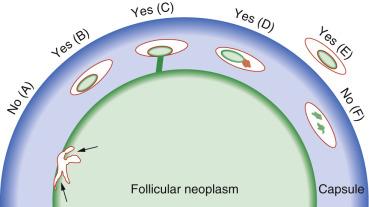
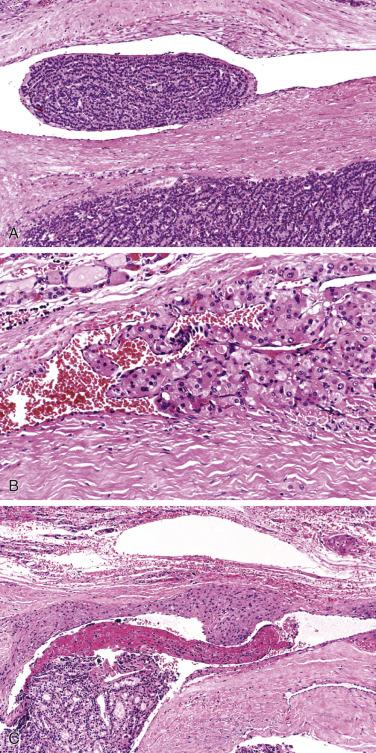
Collections of follicles bulging slightly into the thin-walled capsular vessels can be disregarded if deeper cuts and further sampling fail to reveal more convincing vascular invasion ( Fig. 18A.43 ). Retraction artifacts around tumor islands can be distinguished from vascular invasion by absence of endothelial lining in the space ( Fig. 18A.44 ). Sometimes irregular clusters of nonendothelialized tumor with ragged borders and not conforming to the contour of blood vessels may be seen inside the capsular vessels; they result from artifactual dislodgment of the tumor during cut-up of the specimen and should not be counted as vascular invasion ( Fig. 18A.45 ).
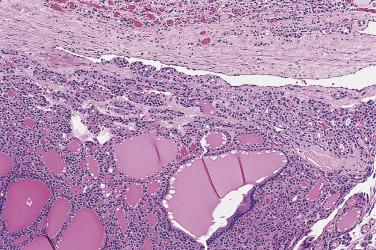
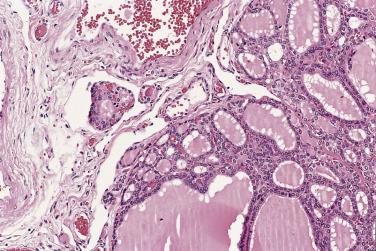
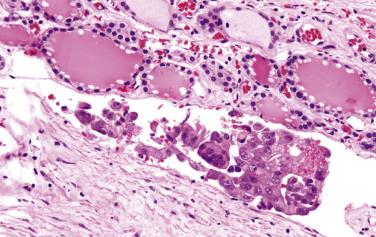
A rare occurrence that may simulate vascular invasion is intravascular endothelial hyperplasia occurring in capsular blood vessels. Careful scrutiny will reveal that the intravascular polypoid plug is formed by plump spindled endothelial cells and pericytes, which are quite different from neoplastic follicular epithelial cells ( Fig. 18A.46 ). Nonetheless, although intravascular endothelial hyperplasia per se does not constitute vascular invasion, this finding warrants more careful sampling and examination to look for genuine vascular invasion elsewhere.
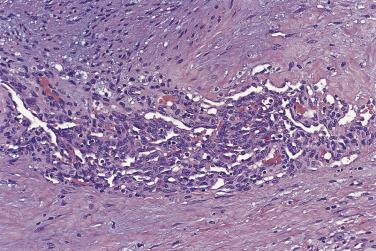
To qualify for capsular invasion, there must be complete transgression of the fibrous capsule— that is, the tumor bud has to extend beyond an imaginary line drawn through the external contour of the capsule ( Fig. 18A.47 ). The problems in assessment of capsular invasion are explained in Figs. 18A.48 and 18A.49 . Tumors exhibiting features short of complete capsular transgression after extensive sampling and careful assessment should not be given a label of carcinoma, although some authors accept incomplete capsular invasion as being sufficient for the diagnosis of follicular carcinoma. One major differential diagnosis is capsular rupture due to prior fine-needle aspiration ( Fig. 18A.50 ).

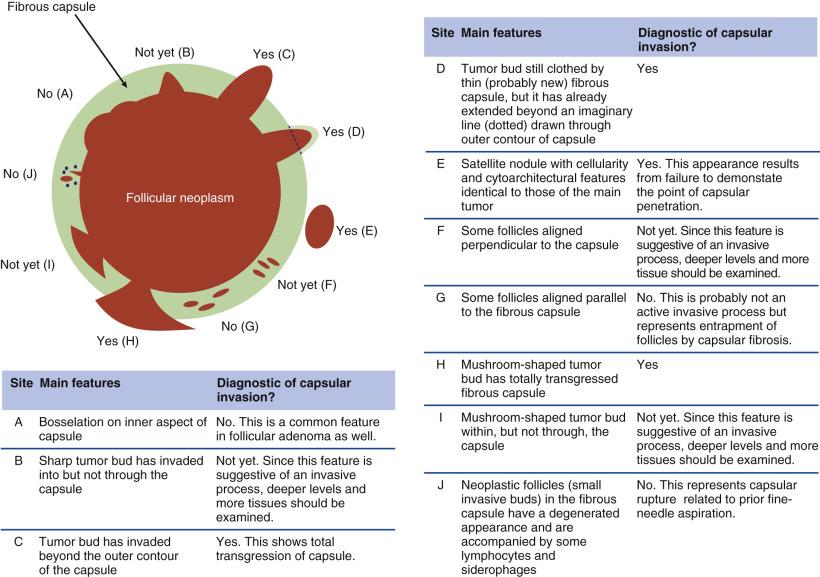
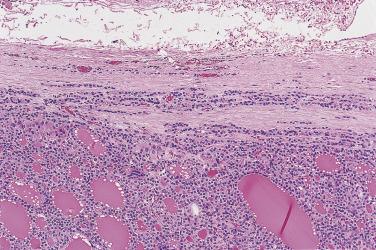

Vascular invasion and capsular invasion are in fact closely related phenomena. Tumors showing vascular invasion frequently show capsular invasion. A tumor bud not uncommonly invades into or through the capsule to extend directly into a vascular space.
Having made a diagnosis of follicular carcinoma, it is important to categorize it further (see Table 18A.7 ).
They are grossly encapsulated tumors showing focal capsular invasion that is usually apparent only on histologic examination (see Figs. 18A.42 and 18A.47 ). These tumors have practically zero risk of metastasis.
They are encapsulated tumors with vascular invasion; capsular invasion may or may not be present. It is preferable to further assess the degree of vascular invasion:
Invasion of less than four blood vessels is associated with a very low rate of metastasis (~5%).
Invasion of four or more blood vessels is associated with a higher risk of metastasis. The cumulative event rate is approximately 18%.
In view of the excellent prognosis, lobectomy with or without suppressive thyroxine therapy is adequate treatment for low-risk patients (see Fig. 18A.5 for risk-group assignment), f
f References .
although some investigators recommend total thyroidectomy for all patients. Total thyroidectomy and radioactive iodine therapy should be considered for high-risk patients; the purpose of total thyroidectomy is to remove all normal thyroid tissue that may compete with any residual or metastatic follicular carcinoma to effectively take up radioactive iodine.
They show widespread infiltration of the thyroid parenchyma and blood vessels, and they often lack complete encapsulation ( Figs. 18A.51 and 18A.52 ). At least a proportion of cases of widely invasive follicular carcinomas reported in the literature represent poorly differentiated thyroid carcinomas. At presentation, regional lymph node metastasis and distant metastasis are already found in 7% and 29% to 66% of cases, respectively. On follow-up, more patients will develop further metastases, especially to the bone and lung. According to one long-term follow-up study, 29% of patients died of disease, 41% were alive with disease, and only 22% were alive without disease. Extension of the tumor into the soft tissues of the neck imparts an unfavorable influence on the survival (event rate 53% at 6 years, compared with 28% for carcinomas confined to the thyroid gland). Widely invasive carcinomas are aggressive neoplasms and thus have to be treated by total thyroidectomy, radioactive iodine, and suppressive thyroxine.
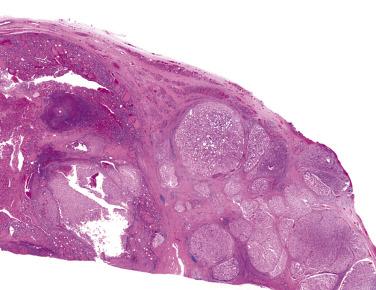
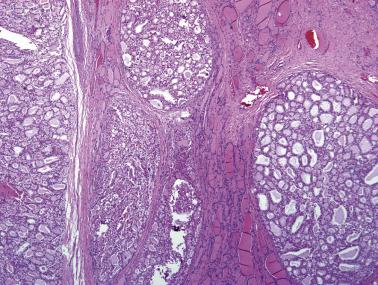
For distinction between follicular carcinoma and adenoma, the capsule has to be completely sampled for histologic examination. Most blocks should be taken from the peripheral portions of the tumor, including the interface with the normal thyroid rather than from the central portions. Since tangential sections render assessment of invasion difficult, it is preferable to make radial cuts to produce wedge-shaped pieces after bisection of the nodule through the greatest diameter.
Hyalinizing trabecular adenoma is an unusual variant of follicular adenoma, which may be mistaken for paraganglioma, medullary carcinoma, or papillary carcinoma. There is an association with chronic lymphocytic thyroiditis. Long-term follow-up shows that the tumor does not recur or metastasize. The hyalinizing trabecular pattern is not totally specific for follicular neoplasm and can be observed focally in colloid nodule, thyroiditis, and otherwise typical papillary carcinoma.
The exceptionally rare examples of hyalinizing trabecular carcinoma are distinguished from hyalinizing trabecular adenoma by the presence of vascular and/or capsular invasion. However, some cases reported as such might have represented FAP-associated cribriform-morular variant of papillary carcinoma instead.
Hyalinizing trabecular adenoma is characterized by long wavy and coiled trabeculae or packets of elongated to polygonal cells with lightly eosinophilic cytoplasm ( Fig. 18A.53 ). The elongated tumor cells are aligned perpendicularly in the trabeculae. There are frequently interspersed microcysts and larger cystic spaces representing abortive or true follicle formation. The oval nuclei exhibit fine chromatin, and some degree of pleomorphism may be present. Nuclear grooves, pseudoinclusions, and perinucleolar halo are frequent findings (see Fig. 18A.53B ). There are unique cytoplasmic yellow bodies, which are often perinuclear, pale yellow, spherical, and refractile, measuring up to 5 µm; they are surrounded by a clear halo, and are shown ultrastructurally to represent giant lysosomes ( Fig. 18A.54 ). The delicate fibrovascular stroma tends to undergo hyalinization, sometimes in the form of lumpy eosinophilic deposits merging with the tumor cells. Calcified colloid, usually associated with the abortive follicles, may be seen. The tumor shows thyroglobulin immunoreactivity, which may be confined to the microcysts and follicles. TTF1 is expressed by most tumor cells. Hyalinizing trabecular adenoma frequently shows a unique pattern of cytoplasmic granular and cell membrane staining with MIB1 antibody, but not the polyclonal Ki67 antibody.
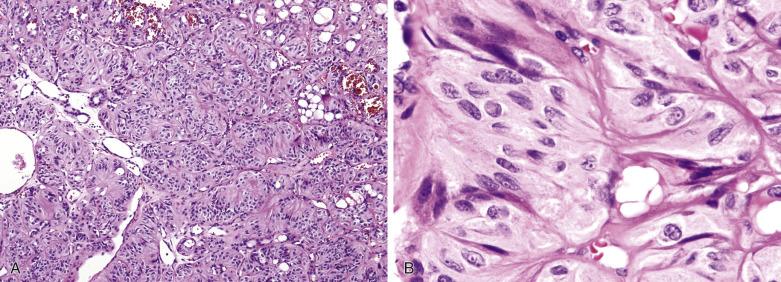
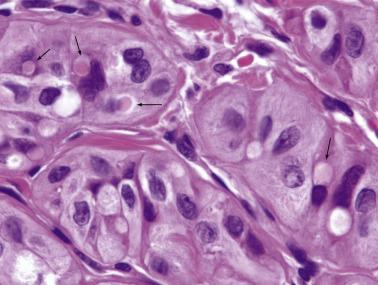
The nosologic nature of hyalinizing trabecular adenoma/carcinoma has been controversial, leading to the noncommittal designation hyalinizing trabecular tumor adopted in the 2017 WHO classification. Some authors believe that this tumor represents an unusual variant of papillary carcinoma, based on the following observations: (1) merging with or coexistence with typical papillary carcinoma in some cases, (2) focal hyalinizing trabecular neoplasm–like areas that can be seen in some typical papillary carcinomas, (3) striking similarities in nuclear features to papillary carcinoma, (4) similarities in immunohistochemical profile (such as high molecular weight cytokeratin, CK19, basement membrane deposition) in at least a proportion of cases, and (5) demonstration of RET/PTC translocation in a proportion of cases. However, there are stronger arguments against this postulation: (1) Other studies have not found expression of high molecular weight cytokeratin and CK19 (hallmarks of papillary carcinoma). (2) The frequency of galectin-3 expression is much lower than in papillary carcinoma (40% vs 83%). (3) The diagnosis of some cases of hyalinizing trabecular tumor included in studies that have demonstrated RET/PTC translocation may not be reliable, and another study fails to detect RET/PTC in hyalinizing trabecular adenoma. (4) HBME1 is consistently negative. (5) BRAF mutation, a characteristic molecular feature of papillary carcinoma, is not found. (6) The microRNA (miRNA) expression pattern is significantly different from that of papillary carcinoma. (7) Hyalinizing trabecular adenoma has been shown to exhibit a distinctive PAX8-GLIS3 gene fusion, and less commonly PAX8-GLIS1 gene fusion, as the genomic hallmark.
It exhibits discrete cytoplasmic vacuoles, which displace the nuclei to one side ( Fig. 18A.55 ). The cytoplasmic vacuoles often show the staining properties of mucosubstances and are furthermore immunoreactive for thyroglobulin. They correspond ultrastructurally to intracellular lumens lined by microvilli. Signet ring cell changes can be focal or diffuse, and this pattern may merge into microcystic spaces filled with extracellular mucin.
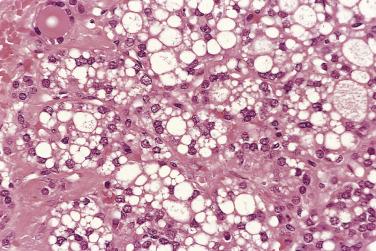
This variant shows accumulation of abundant extracellular basophilic mucinous material, often accompanied by a microcystic, reticular, or even multicystic growth pattern. Some large mucinous pools can also be produced ( Fig. 18A.56 ). In some cases, signet ring cell change may be observed in the neoplastic epithelium.

Clear cell change can occur in a wide variety of tumors in the thyroid (follicular neoplasm, papillary carcinoma, medullary carcinoma, intrathyroid parathyroid tumor, metastatic renal cell carcinoma) as well as in the normal or hyperplastic thyroid gland (see Table 18A.8 ). The mechanisms include ballooning of mitochondria, accumulation of lipid (lipid-rich adenoma), accumulation of glycogen, or deposition of intracellular thyroglobulin.
Clear cell follicular neoplasms are composed of follicles, trabeculae, or solid sheets ( Fig. 18A.57 ); vascular/capsular invasion is the only criterion to distinguish carcinoma from adenoma. Should there be any doubt about the line of differentiation, immunostaining for thyroglobulin or TTF1 will be confirmatory.
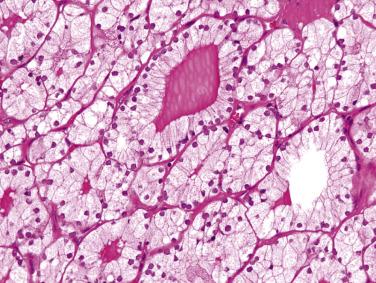
This is a benign tumor occurring predominantly in children and adolescents. It is encapsulated, partially cystic, and composed of papillae and follicles ( Fig. 18A.58 ). The nuclei are round, hyperchromatic, and regularly aligned at the base of the cells. By definition they lack the nuclear features of papillary carcinoma. Hemosiderin deposition is common in the luminal macrophages and follicular epithelium.
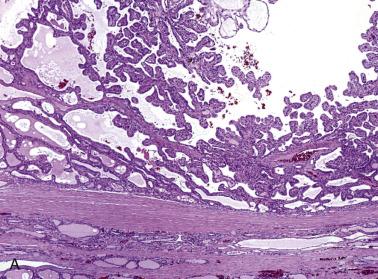
This is a controversial entity, in particular whether it is a form of papillary carcinoma or a follicular neoplasm. Woodford et al have shown that it should be considered a follicular neoplasm. The tumor is defined as an encapsulated thyroid tumor composed of oncocytic cells, with more than 50% papillary architecture and lacking the typical nuclear features of papillary carcinoma, although rare nuclei reminiscent of papillary carcinoma are allowable. True arborizing papillae are covered by oncocytic cells, often with hobnail appearance ( Fig. 18A.59 ). About half of the cases show capsular or vascular invasion (with such cases being considered minimally invasive or encapsulated angioinvasive follicular carcinomas). There is no immunohistochemical or molecular evidence to suggest a relationship with papillary carcinoma (HBME1−, CK19−, CD56+, no BRAF mutation, and no RET/PTC rearrangement). On follow-up of 3 months to 13 years, 12 patients were alive with no local recurrence, and 1 patient developed cervical nodal metastasis at 1 year.
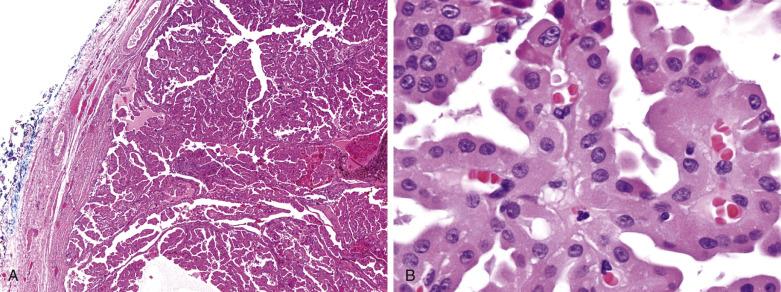
Rare follicular adenomas are hyperfunctioning (also known as hot or toxic adenomas), with autonomous production of thyroxine. The tumor appears as a hot nodule on radioactive iodine scan. It comprises normal-sized or small follicles, lined by tall columnar cells that form papillary infoldings, reminiscent of the follicles seen in Graves disease ( Fig. 18A.60 ). Activating somatic mutations of the genes encoding the thyroid-stimulating hormone receptor or α−subunit of stimulatory G protein are commonly found.
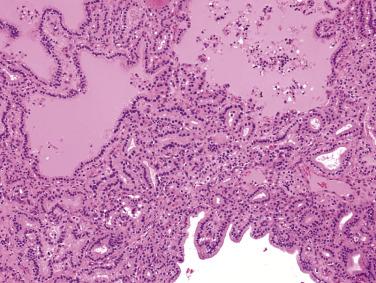
The rare adenolipoma (lipoadenoma) is a follicular adenoma containing interspersed mature fat cells. Even more rarely, fat cells can occur inside follicular carcinoma. Exceptional examples of follicular adenoma with extensive chondroid metaplasia have been reported.
Partial or complete infarction of follicular neoplasms sometimes occurs after fine-needle aspiration. The main findings are coagulative necrosis, hemorrhage, accumulation of macrophages, and variable degrees of organization by fibrogranulation tissue ( Fig. 18A.61 ), depending on the time interval between the needle aspiration and the excision. A peripheral thin rim of viable tumor may still be present in some cases. Interestingly, for follicular carcinomas showing total infarction, the invasive buds often remain viable, probably because the infarction results from compromise of the blood supply to the intracapsular portion of the tumor through increased intralesional tension resulting from the hemorrhage. Infarction may create problems in diagnosis:
Difficulties may occur in recognizing the true nature of the tumor.
Exuberant granulation tissue (plump stromal cells with vesicular nuclei) mixed with macrophages may invite an erroneous diagnosis of anaplastic carcinoma ( Fig. 18A.62 ). The subsequent fibrosis may break up the residual tumor into irregular islands, creating a pseudoinfiltrative pattern ( Fig. 18A.63 ).
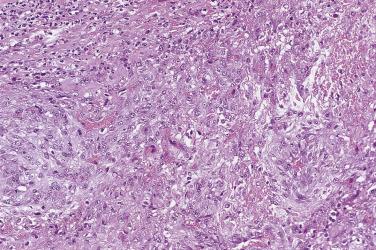

The islands of residual tumor around the infarct may show striking reactive nuclear atypia, leading to an erroneous diagnosis of high-grade carcinoma. Follicular dilatation may also result in an angiosarcoma-like pattern.
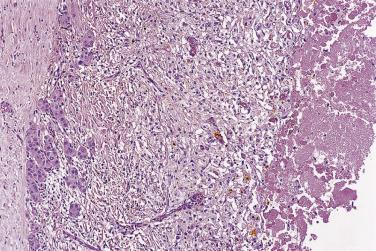
Rarely, a follicular neoplasm can show a variable component of bland-looking neoplastic spindle cells, forming short fascicles or even perivascular whorls ( Fig. 18A.64 ). The chromatin is fine, and nucleoli are inconspicuous. The metaplastic nature of the spindle cells can be confirmed by positive staining for cytokeratin, thyroglobulin, and TTF1; the proliferative fraction is very low.
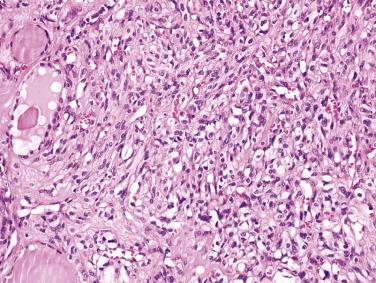
Follicular neoplasms showing generalized nuclear atypia, giant cells, or coagulative necrosis but that lack vascular/capsular invasion after thorough sampling are labeled atypical adenoma ( Fig. 18A.65 ). They pursue a benign course, as has been documented by long-term follow-up studies.

This variant refers to an otherwise typical follicular adenoma, which contains interspersed huge cells with bizarre hyperchromatic nuclei.
A follicular carcinoma comprised of unusual glomeruloid follicles has been reported. A follicular carcinoma has been reported to have abundant extracellular amorphous globular structures made up of basement membrane materials, mimicking adenoid cystic carcinoma. We have encountered a hyalinizing follicular carcinoma with abundant hyaline deposits, resulting in an intracanalicular or phyllodes growth pattern in areas.
Immunohistochemistry is usually not required except for tumors with unusual morphologic features such as prominent fibrovascular septa, signet ring cells, clear cells, or a hyalinizing trabecular pattern, mainly to confirm the follicular nature of the neoplasm, such as by positive staining for thyroglobulin.
Various antibodies have been studied for their potential value in the distinction between follicular carcinoma and adenoma, but none has so far been shown to be foolproof.
Various tumor markers such as carcinoembryonic antigen, oncogene products (RAS p21, MYC), cyclin-dependent kinase inhibitor (p27), proliferation marker (Ki67), epidermal growth factor, P-glycoprotein, and high mobility group I HMGI(Y) protein have not been proven to be helpful.
Although some antibodies such as tissue polypeptide antigen, dipeptidyl aminopeptidase IV, Leu7, thyroid peroxidase (MoAb 47), HBME1, galectin-3, CITED1, matrix metalloproteinase-2, matrix metalloproteinase-7, and cyclooxygenase-2 are reported to show differential staining of follicular adenomas and follicular carcinomas, the low discriminatory power precludes their application for routine diagnostic purposes. Moreover, the marked differences in the reported positivity rates in the different studies suggest that technical factors and interpretation criteria may significantly affect the results. Some studies have promoted the application of a panel of antibodies instead, but there is no consensus on the most optimal panel.
So far clear-cut differences have not been shown between follicular adenoma and follicular carcinoma in terms of cytoarchitecture, histomorphometry, immunophenotypic profile, DNA ploidy, or molecular alterations. Up to 27% of adenomas may show aneuploidy, yet the patients remain well on follow-up of more than 5 years. Furthermore, the prevalence of RAS oncogene mutation is nearly as high in follicular adenoma as in follicular carcinoma.
If one accepts that some follicular adenomas are in reality in situ carcinomas, the abovementioned results make sense. The attempt to derive clear-cut discriminatory parameters will be futile when one compares follicular carcinomas with a mixture of adenomas and in situ carcinomas. However, for management purposes, it is not important to identify these hidden in situ carcinomas, which lack metastatic potential. Currently histologic evaluation remains the gold standard in the distinction between follicular carcinoma and follicular adenoma.
Three major nonoverlapping molecular pathways are implicated in follicular neoplasms.
PAX8/PPARγ fusion resulting from t(2;3)(q13;p15) occurs in 20% to 50% of all cases of follicular carcinomas and 10% of cases of follicular adenomas. PAX8 encodes a transcription factor that plays an important role in thyroid development and differentiation, while PPARγ encodes the peroxisome proliferator-activated receptor. The gene fusion is not found in other thyroid neoplasms except NIFTP. Follicular carcinomas that carry PAX8/PPARγ tend to be locally invasive, but they may have a lower risk of distant metastasis compared with tumors lacking the gene fusion.
Activating point mutations of the RAS genes occur in 20% to 40% of follicular adenomas and 30% to 50% of follicular carcinomas, suggesting that RAS mutation represents an early event in tumorigenesis. NRAS mutation is the most common, most often involving codon 61 with CAA(Gln)→CGA(Arg), followed by HRAS mutation, also involving codon 61. KRAS mutation is very rare.
The PI3K/PTEN/AKT pathway is involved in 10% to 20% of cases of follicular carcinomas. Somatic inactivating mutations of the PTEN gene (point mutations or small frameshift deletions) and PIK3CA gene are found in 5% to 10% of cases each.
The clinical outcome of follicular carcinoma can often be predicted by risk-group assignment (see Fig. 18A.5 ). The 20-year survival rates for low–risk, intermediate-risk, and high-risk group patients are 97%, 87%, and 49%, respectively. The natural history is depicted in Fig. 18A.35 .
Subtype of follicular carcinoma. Minimally invasive type and encapsulated angioinvasive type with limited vascular invasion have a much better prognosis than the encapsulated angioinvasive type with extensive vascular invasion and widely invasive type (see Table 18A.7 ).
Metastasis. Distant metastasis at presentation is a highly unfavorable prognostic factor. g
g References .
Age. Patients below the age of 30 to 40 years have a much better prognosis than older patients. h
h References .
Sex. Some studies have shown the male gender to be associated with a worse prognosis.
Histologic type. Various studies have not reported consistent influence of the histologic pattern on prognosis. Cases showing a solid or trabecular pattern in more than 75% of the tumor area are associated with a worse prognosis, but some such cases may be reclassified as poorly differentiated thyroid carcinoma by current criteria.
Size of tumor. Tumor size over 4 cm is associated with a worse prognosis.
Adenomatous (colloid) nodule. Follicular adenoma is distinguished from adenomatous nodule by the following features: (a) solitary lesion, (b) presence of a fibrous capsule, and (c) cytoarchitecture different from that of the surrounding thyroid (usually smaller follicles, more solid growth, and larger nuclei). The distinction, however, is sometimes arbitrary, although this is not important for management purposes.
Hashimoto thyroiditis and dyshormonogenesis. The multiple hyperplastic nodules sometimes found in Hashimoto thyroiditis or dyshormonogenetic goiter may raise a concern for widely invasive follicular carcinoma. In these lesions, vascular invasion is absent, and the different nodules typically show different cytoarchitecture and cellularity.
Intrathyroid parathyroid tumor. Parathyroid tumors arising within the thyroid gland can simulate a microfollicular thyroid neoplasm, clear cell thyroid tumor, and Hurthle cell tumor. See “ Intrathyroid Parathyroid Tumor ”. The clinical information (hypercalcemia) and immunostaining for parathyroid hormone can solve the diagnostic problem.
Medullary carcinoma. The glandular, oncocytic, and hyalinizing trabecular types of medullary carcinoma can mimic follicular neoplasms. The presence of prominent fibrovascular septa should always raise the possibility of medullary carcinoma. Therefore, for any unusual looking follicular neoplasm, immunohistochemical studies should be performed.
Papillary carcinoma. Pale or clear nuclei are not uncommonly encountered in follicular neoplasms, particularly in the central portion of the tumor where fixation is delayed, resulting in artifactual blowing up and clearing of the nuclei ( Fig. 18A.66 ). It is most important not to overinterpret such nuclear changes as being indicative of papillary carcinoma.
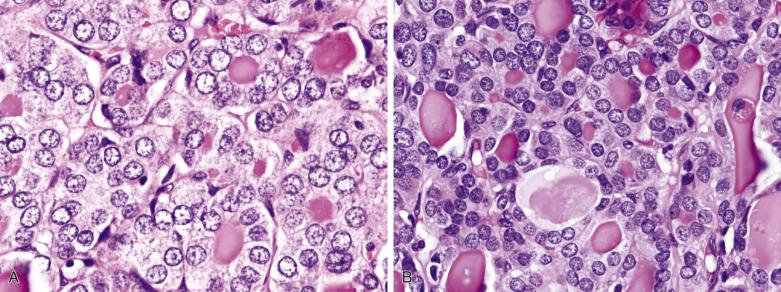
Hurthle cell neoplasms are follicular neoplasms comprising more than 70% oncocytic cells. They are classified, as for follicular neoplasms, into Hurthle cell adenoma (no invasion) and Hurthle cell carcinoma (minimally invasive, encapsulated angioinvasive, and widely invasive types) (see Table 18A.7 ). Other specific tumor types, such as papillary carcinoma, medullary carcinoma, and poorly differentiated carcinoma, with oncocytic cells are not included in this category.
Whether Hurthle cell neoplasms should be considered a distinct entity or merely a variant of follicular neoplasms is open to debate, but they do show differences in clinical, pathologic, and mutational profile.
The clinical presentation is similar to that of follicular neoplasms. Hurthle cell carcinomas tend to occur in an older age group (mean 55 years vs 45 years) and be larger (4.3 cm vs 2.9 cm) compared with Hurthle cell adenomas. There is female predominance, which is more striking in Hurthle cell adenoma than Hurthle cell carcinoma (F:M ratio 8 : 1 vs 1.8 : 1). Most Hurthle cell neoplasms are solitary, but rare ones may be multifocal or bilateral.
As a group, the frequency of malignancy is higher for Hurthle cell (35%) compared with non-Hurthle cell follicular neoplasms. A size of 4 cm or larger is strongly correlated with malignancy among Hurthle cell neoplasms.
Although studies in the 1970s and early 1980s suggested that all Hurthle cell neoplasms, irrespective of whether invasion could be demonstrated histologically, should be treated aggressively because all were potentially malignant, many further studies have convincingly shown that the presence or absence of capsular/vascular invasion can accurately predict the behavior of these tumors ( Fig. 18A.67 ). i
i References .
Those with no invasion are curable by nodulectomy or lobectomy, while those showing invasion (carcinoma) can recur locally, metastasize to regional lymph nodes, or show distant metastasis (especially to bone and lungs). In fact, a proportion of patients with Hurthle cell carcinoma already show distant metastasis at presentation.
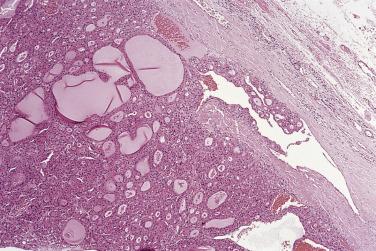
Compared with conventional follicular carcinomas, Hurthle cell carcinomas generally take up radioactive iodine less satisfactorily; show a higher frequency of extrathyroidal extension, local recurrence, and metastasis to lymph nodes and soft tissues of neck; and overall are more aggressive. Nonetheless, many of the differences are not evident when the two groups are stratified according to the extent of invasion. The overall mortality rate of Hurthle cell carcinomas is about 30% to 70%, and the median survival is 55%. Old age, male gender, large tumor size (>4 cm), extensive vascular invasion, extensive extrathyroidal extension, and nodal metastasis are correlated with a worse prognosis. Minimally invasive Hurthle cell carcinoma has a practically 0% adverse event rate.
Hurthle cell neoplasms are composed of cells with abundant brightly eosinophilic granular cytoplasm ( Fig. 18A.68 ), due to accumulation of mitochondria (i.e., oncocytes). As with all mitochondrion-rich tumors, they are bright brown macroscopically. The cytoplasm may exhibit partial to complete clearing due to ballooning of the mitochondria. The cells are arranged in small follicles, trabeculae, packets, or sometimes papillae (see Fig. 18A.68 ). The colloid may be calcified, mimicking psammoma bodies (see Fig. 18A.68D ). The nuclei are round, with granular to coarse chromatin and distinct nucleoli. Scattered cells not uncommonly show nuclear grooves or nuclear pseudoinclusions (see Fig. 18A.68B ) and thus may raise a concern for the diagnosis of papillary carcinoma. There are commonly some interspersed large nuclei, and some degree of nuclear pleomorphism is common. Hurthle cell neoplasms have a tendency to undergo infarction spontaneously or after fine-needle aspiration.
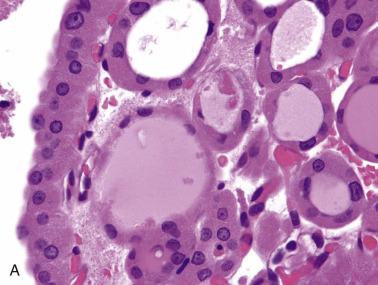
Hurthle cell tumors have a lower frequency of RAS mutation (0%–17% among adenomas and 12%–25% among carcinomas) compared with follicular neoplasms. In contrast to follicular neoplasms, PAX8/PPARγ gene rearrangement is practically not found in Hurthle cell neoplasms. Aneuploidy is characteristic, typically involving whole chromosomes or large chromosome segments. The gene expression profiles of Hurthle cell neoplasms are distinct from those of follicular neoplasms. In widely invasive Hurthle cell carcinomas, there is commonly activation of the WNT-β-catenin and PI3K-PTEN-AKT pathways.
Hurthle cell neoplasms commonly show large deletions of mitochondrial DNA (mtDNA), mutations of mtDNA genes coding for oxidative phosphorylation (OXPHOS) proteins, and mutations of nuclear genes coding also for mitochondrial OXPHOS proteins. These alterations are thought to lead to energy production defects and hence an increased proliferation of mitochondria as a compensatory mechanism.
Rendering a diagnosis on an encapsulated follicular-patterned tumor that lacks nuclear features of papillary carcinoma is usually straight forward: follicular adenoma (with no invasion) or follicular carcinoma (with capsular and/or vascular invasion) ( Fig. 18A.69 ). When invasion is equivocal, a diagnostic label follicular tumor of uncertain malignant potential can be applied.

For an encapsulated follicular-patterned tumor with definite invasion (and hence undoubtedly a carcinoma) but showing nuclear features indeterminate between papillary carcinoma and follicular carcinoma, a diagnostic label well-differentiated thyroid carcinoma, NOS can be used to express uncertainty regarding the biologic nature of the carcinoma (see Fig. 18A.69 ).
Encapsulated follicular-patterned tumors with definite or equivocal nuclear features of papillary carcinoma have been particularly problematic and controversial. In the 2017 WHO classification, cases lacking invasion are given the designation noninvasive follicular thyroid neoplasm with papillary-like nuclear features, while those showing invasion are designated invasive encapsulated follicular variant of papillary carcinoma (see Fig. 18A.69 ) .
NIFTP is a noninvasive tumor of thyroid follicular cells with a follicular growth pattern and nuclear features reminiscent of papillary thyroid carcinoma and having an extremely low malignant potential (see Fig. 18A.69 ). Before introduction of the NIFTP nomenclature, such tumors were usually labeled noninvasive encapsulated follicular variant of papillary carcinoma, or in the hands of pathologists using strict criteria in diagnosing papillary carcinoma, follicular adenoma . This group accounted for approximately 20% of all papillary thyroid carcinomas.
Despite being listed as an entity in the 2017 WHO classification, NIFTP is probably not a tumor entity but merely an interim designation for a diagnostic problem. The majority of cases are probably merely follicular adenomas, and only a minority represent genuine papillary carcinomas (follicular variant). The nomenclature is also inconsistent in that once there is capsular or vascular invasion, the designation of such a tumor goes from a follicular neoplasm to encapsulated invasive follicular variant of papillary carcinoma; the majority of such cases are probably merely follicular carcinomas.
While the reproducibility in diagnosis of the infiltrative type of follicular variant papillary carcinoma is high, the intraobserver and interobserver reproducibility in diagnosis of encapsulated follicular neoplasms with well or partially developed nuclear features of papillary carcinoma is very low. Different pathologists have very different thresholds in rendering a diagnosis of encapsulated follicular variant of papillary carcinoma (vs follicular adenoma/carcinoma). Some take a conservative approach, rendering this diagnosis sparingly and only when the nuclear features are very classic, in view of the excellent outcome (no recurrence or metastasis after surgery, even with lobectomy alone) in the absence of capsular or vascular invasion. On the other hand, many pathologists take a liberal approach, readily rendering a diagnosis of encapsulated follicular variant papillary carcinoma (even in the presence of only minimal nuclear features of papillary carcinoma, such as nuclear pallor alone), at least partly driven by the litigation climate.
Recognizing the problem of overdiagnosis and overtreatment of this so-called cancer, an international group of investigators reexamined the entity through review of cases with long follow-up and recently proposed the new nomenclature of NIFTP, deliberately avoiding the descriptor carcinoma (see Fig. 18A.69 ).
The patients usually present with solitary thyroid nodule, but the tumors can be bilateral or multifocal. Although the original study only included tumors measuring 1 cm or more, subcentimeter (≤1 cm) and large tumors (≥4 cm) can also be encountered.
According to four large series, including a total of 394 patients, no patients had adverse events on mean/median follow-up of 5.8 to 13 years. In a study of 95 cases, 2% of patients had micrometastasis in central compartment lymph node. In another study of 102 cases, 5% of patients had local lymph node metastasis and 1% had lung metastasis. The American Thyroid Association currently recommends management as for low-risk differentiated thyroid carcinoma.
The diagnostic features of NIFTP are listed in Box 18A.3 ; some diagnostic criteria have been tightened since the original description, including the need for complete sampling of the tumor for histologic examination and not accepting presence of any true papillae ( Fig. 18A.70 ). It has even been suggested that immunostaining for BRAF V600E be performed routinely to exclude papillary carcinoma.
Become a Clinical Tree membership for Full access and enjoy Unlimited articles
If you are a member. Log in here